
AUTUMN 2023 EDITION 14 SPRAY CALIBRATION TIPS Industry 24 ORGANIC FARMER OF THE YEAR Strawberries 65 NITROGEN REMOVAL TRIALS Blueberries 89 YOUNG LEADERS EMERGING Rubus 100 AUSTRALIAN BERRY JOURNAL


NEWS FROM OUR VALUED PARTNERS
PARTNERS "The outstanding thing was the longevity of the produce." - Jim Rozaklis, strawberry grower, Bathurst NSW Contact your local Syngenta representative for more information. ® Registered trademark of a Syngenta Group Company. AD23/134
SILVER
Jenny Van de Meeberg
John Hay
Bronwyn Koll
Dr Anne-Maree Boland
Scott Wallace
Craig Shephard
Liam Southam-Rogers
Henry Hyde
Dave Farmer
Christopher Menzel
John Gray
Wherever you see this logo, the initiative is part of the Hort Innovation Blueberry, Strawberry and Raspberry and Blackberry Fund. Like this publication itself, it has been funded by Hort Innovation using the Blueberry, Strawberry and Raspberry and Blackberry R&D levy and contributions from the Australian Government. Some projects also involve funding from additional sources.
DISCLAIMER: Whilst every care has been taken in the preparation of this journal, the information contained is necessarily of a general nature and should not be relied upon as a substitute for specific advice. The advice and opinions in the articles published in Australian Berry Journal are essentially those of contributors and do not necessarily reflect the views of Berries Australia or the Editor. The advice is at the reader’s own risk, and no responsibility is accepted for the accuracy of the material presented. Inclusion of an advertisement in this publication does not necessarily imply endorsement of the product, company or service by Berries Australia or the Editor. Horticulture Innovation Australia Limited (Hort Innovation) makes no representations and expressly disclaims all warranties (to the extent permitted by law) about the accuracy, completeness, or currency of information in Australian Berry Journal. Reliance on any information provided by Hort Innovation is entirely at your own risk. Hort Innovation is not responsible for, and will not be liable for, any loss, damage, claim, expense, cost (including legal costs) or other liability arising in any way, including from any Hort Innovation or other person’s negligence or otherwise from your use or non-use of Australian Berry Journal or from reliance on information contained in the material or that Hort Innovation provides to you by any other means. Copyright © Horticulture Innovation Australia Limited 2022 Copyright subsists in Australian Berry Journal. Horticulture Innovation Australia Limited (Hort Innovation) owns the copyright, other than as permitted under the Copyright ACT 1968 (Cth). Australian Berry Journal (in part or as a whole) cannot be reproduced, published, communicated or adapted without the prior written consent of Hort Innovation. Any request or enquiry to use the Australian Berry Journal should be addressed to: Communications Manager, Hort Innovation, Level 7 | 141 Walker Street, North Sydney 2060, Australia | E: communications@horticulture.com.au | P: 02 8295 2300

Emerging Leader: Tom Considine 85 Growing young horticulturalists at Costa Berries in Western Australia 86 Natural based systems in treating blueberry irrigation runoff: a best practice trial in NSW 89 Marketing Update 95 BLUEBERRIES Attracting and retaining staff starts with your business 14 NEW: Coir recycling and reuse project gets underway 17 Smart Farming Guide for Horticulture 19 Tasmania: Berry Sprayer Field Day 24 The future of berries: Are we doing enough to meet technology half-way? 28 Asia Fruit Logistica: Reflections on the Thai market 32 Area wide pest management: an essential approach to fruit fly management 38 NEW: Recovery & Resilience — A Berries Australia & Hort360 Project 40 National Agricultural Plastics Stewardship Scheme — Update 43 Australian Horticulture Statistics Handbook 2021/22 available online now 48 National map of Protected Cropping Systems now available in draft 49 Market Update: Fruit volume down in the wake of increased prices and supply issues 52 Energy Efficiency for Recovery and Resilience Case Studies 55 INDUSTRY Profile: Rainberry Farm, Tasmania 97 Profile: Jamie Pollen, Queensland Berries, Qld 100 RUBUS Hort Innovation Strawberry Levy: An Update 60 Strawberry growers to receive targeted climate information. 61 Queensland Strawberry farmer wins Australian Organic Farmer of the Year 65 Inconsistent quality under global warming dampens strawberry performance in SEQ 70 Out and about in the Victorian strawberry industry 75 Growing Strawberries in Scotland 81 STRAWBERRIES AUTUMN 2023 EDITION 14 AUSTRALIAN BERRY JOURNAL ADVERTISING For all Advertising & Partnership Enquiries Wendy Morris | 0491 751 123 | admin@berries.net.au All advertising and advertorial material is subject to review and approval prior to publication. DESIGN Sama Creative www.samacreative.com.au EDITOR Jane Richter TERES Communication 0431 700 258 jane@teres.com.au CONTRIBUTORS Rachel Mackenzie Anthony Poiner Simon Dornauf Andrew Bell Richard McGruddy Melinda Simpson Dr Angela Atkinson Mark Salter Helen Newman Aileen Reid Jen Rowling Dr Mark Bayley Meg Strang David Cordina Delaney Lang-Lemckert
Executive Director's Report
Rachel Mackenzie | 0408 796 199 | rachelmackenzie@berries.net.au
Welcome to the first Australian Berry Journal of 2023. We are fortunate to have horticulture communications specialist Jane Richter as the editor of this publication and a recent grower survey indicated that the journal is the preferred way for growers to obtain information. We are proud of the journal so it is encouraging that so many growers use it and appreciate it.
As I am sure most of you are aware, this journal is partly funded through levy funds matched by the Australian government. Funds raised through advertising also make up a significant proportion of the funding for the journal so I encourage you all to continue to support our advertisers and sponsors, so we can continue to support you.

We are currently negotiating the next iteration of the industry development and communications project and as part of that process we want to ensure that the project delivery meets the needs of the levy payers. There was consistent feedback across the growing regions that all growers were keen for more information on pest and disease management, ongoing access to agricultural chemicals and irrigation and nutrition information. These topics will form the backbone of the next project. It is important though to remember that this is an industry development project so we need to look at the broader issues that are coming over the hill, so to speak. Grower profitability is consistently raised as an issue and that covers off on issues such as increasing costs for agricultural inputs and labour, compliance costs as well returns to growers.
Increasing domestic consumption is one way of increasing returns. Marketing is one tool but also trying to ensure the consumer has the best possible eating experience every time they eat an Aussie berry is critical. When times are tough it is tempting (and sometimes unavoidable) to just think of making a dollar this season, but as an industry we need to safeguard our future and ensure our quality is as good as it can be year-round.
Export is another important mechanism increase consumption but we must remember that overseas consumers are wanting evidence of our ‘clean, green’ credentials so sustainability in all its forms will be a driver over the next few years. Our Export Manager Jenny Van de Meeberg will shortly be visiting growers across the country as part of the Joint Berry Export Trade Development project. If any growers are either exportcurious, or would like to further develop current export activity, please let your IDO know and we can arrange to have Jenny visit your farm during her time in your region.
To my mind, many people overlook the fact that profitability is a key element of sustainability, but we do need to move towards a scenario where we are not only doing the right thing but can demonstrate that we are. I strongly encourage growers in Northern NSW to undertake the Hort360 on-farm assessment which gives you a mechanism to benchmark your performance and identify areas of improvement. SEE PAGE 40.
The Varroa mite issue has meant I have spent a lot of time in Coffs lately but hopefully we should soon be in a position to enable pollination to occur and everyone will adapt to the new normal. I am planning to get around to other growing regions as the year progresses. Hopefully 2023 will be the year I finally get to Western Australia!
2 INDUSTRY BERRY AUSTRALIAN JOURNAL AUTUMN 2023 EDITION 14
Chairman's Report
Anthony Poiner | 0412 010 843 | anthony@smartberries.com.au
As I write this column, it is the first day of autumn, and an opportunity to reflect on what has been an unusual and challenging summer for the Australian berry industry. That said, after a few years of pandemic combined with extreme weather events the challenges this year have been much more within the “normal” range of issues that we as growers encounter.

Ironically the weather in the Coffs region before Christmas was fantastic for growing berries. Whilst this would normally be a cause for celebration, the upshot was that we had a huge influx of rabbiteye entering the market that far exceeded forecasts. In addition to the sheer volume, disappointingly the quality was not great and consequently prices went way down.
In the last few weeks, we have seen the quality improving a great deal and consumers have rewarded us with a bounce back up in price. This is a clear and timely reminder of the importance of quality if we want to increase repeat purchases from families, and grow the market overall. Unlike extreme weather events and pandemics, we can actually fix this issue by having a strong focus on quality and overall profitability rather than just volume.
In general the impact of the rabbiteye flush and late crops of cherries and other fruits has made pricing more difficult for all berry categories. That said, I’ve
recently enjoyed eating a lot more sweet and clearly high quality strawberries on shelves lately. The shift towards developing a premium offering in strawberries mirrors the successful approaches taken overseas.
At this stage, I am not so sure that consumers are fully appreciating which are the sweeter packs and which are not, but I am sure the growers of those varieties will be undertaking strategies to differentiate their product in consumers’ minds. This bodes well for the strawberry industry.
In relation to Rubus, there is the prospect of a strong upcoming raspberry season. In general, the word I am hearing is that, although summer and autumn crops have been delayed, there is the anticipation that autumn crops might be strong in yield and potentially early. Obviously, there are challenges in the Coffs region around varroa, but I am also aware that the Berries Australia team is working hard to reduce the impact on growers in the region and at this stage there is no reason to think that yields will be affected. Please spare a thought for our New Zealand berry industry cousins. The impact of Cyclone Gabrielle in many berry growing regions has been nothing short of horrendous. We are thinking of you whilst you pick up the pieces and rebuild your farms.
Once again, thank you to the staff of Berries Australia, the IDO team and each of the peak bodies (SAI, ABGA, and RABA). Your commitment to the cause is appreciated and very important for the continued progress of our industry.
3
INDUSTRY
President's Report
Andrew Bell | 0422 234 124 | andrew@mountainblue.com.au
It is with great pleasure that I pen my first ABGA President’s report. It is not lost on me that I have very large shoes to fill as we have had fantastic leadership over the years. It is also humbling to have this platform to communicate to an industry that my father Ridley helped pioneer in the 1970s. A lot has changed since then – we’ve come from a place of zero production and no real awareness of what a blueberry is, to being a year round staple with 52% market penetration.
Since joining the ABGA committee in 2016, it’s always struck me how collaborative and functional the industry body is. Despite a voluntary levy, we have fantastic buy-in from the majority of industry and a common understanding on the objectives for the committee and the needs of growers. I hope to continue that tradition and whilst our finances remain strong, I would encourage people to continue with timely payment of levies so that we can continue the good work across marketing, R&D research, market access and the like. The establishment of Berries Australia in 2018 has only strengthened our capacity to support growers. As we move into a new phase with increased supply during certain windows, the need for export opportunities continues to be a big priority. Additionally, opening new markets allows us to grow the pie for everyone.

We are particularly excited about the prospect of Vietnam being open to blueberry growers in the near future. The Vietnamese blueberry market is currently modest in size but Vietnam’s potential for premium produce is enormous – since cherries were granted access in 2017,
Australian exports have increased five-fold from AUD$3 million to AUD$15 million. Similarly, since table grapes were granted access in 2016, Australian exports have leapt from AUD$18 million to AUD$38 million. This is rapid export growth in a relatively short period of time. ABGA is working hard to create new market access to Vietnam which will enable our industry to replicate this success for Australian blueberry growers.
It would be remiss of me not to highlight something close to my own heart and that is putting a product on the shelves that we can all be proud of. We’ve just come off the back of a record rabbiteye season, which should mean good things for consumers in terms of value for money. But value for money isn’t just about the lowest price and given the number of complaints I’ve received from consumers and berry lovers about the standard of fruit, we are certainly not delivering value for money. The damage to the category cannot be overstated. I would encourage all industry participants to keep the end consumer front of mind when making planting or harvesting decisions. The simplest way to drive demand for blueberries is to give consumers a positive experience and keep them coming back for more. The ABGA will continue to drive consumption through the marketing program but that investment cannot overcome a poor eating experience.
All in all, I see exciting times for the blueberry industry –with potential market access looming and our continued popularity with consumers. I would also like to extend my support to those growers caught up in the varroa response. I am aware that this is a challenging and uncertain time for you and I encourage you to continue to work closely with the Berries Australia team so they can help you.
4 BERRY AUSTRALIAN JOURNAL AUTUMN 2023 EDITION 14
President's Report
Richard McGruddy | 0408 763 804 | richard@berryq.com.au


Welcome to 2023. It is hard to believe it is March already but here we are. Reports out of Tasmania indicate that there were high volumes of fruit over the summer season. Unfortunately this didn’t translate into high profits for growers as prices were lower than usual due to a combination of factors including a late cherry and summerfruit season. We were also not helped by the bumper crop of lower quality rabbiteye blueberries which impacted the whole berry basket.
The new Horticulture Statistics Handbook (SEE PAGE 48) was released recently which shows the trends for the year to 30 June 2022. After many years of exceptional growth, the Rubus category slowed in the 2021/22 financial year with production dropping by 13% and value dropping by 10%. That said, 2021 was a bumper year with 11,122 tonnes being grown.
The drop can be potentially explained by the flood and hail events that occurred in the Coffs Harbour region in early 2022. Interestingly the price/kg in 2021/22 averaged at $21.33 compared with $20.41/kg the year before. This contrasts with the impressive average of $25.30/kg in 2018. Household penetration sits at 27% (compared with 52% for blueberries).
The clear message from these statistics is that the committee needs to start work now to ensure a profitable future for the sector as supply will soon meet demand. One positive step towards increasing profitability is the levy reduction which will put more money back in your pockets. As discussed many times before, the levy will reduce from 12c/kg to 4c/kg and the indications from government are that it may be activated around October.
RABA, through the Berries Australia export project, is taking initial steps into developing an export capability for berries. This involves identifying some appropriate markets and starting the process for market access. Anyone who has been involved in export understands that these processes can take up to 15 years so it is certainly a good idea to start now. It will be interesting to see if markets in South-East Asia embrace Rubus in the same way they have taken to blueberries, so market education is also part of our strategy.
In addition to export, the industry really has to look at how to increase domestic consumption. We have been in the enviable position whereby the fruit has basically sold itself, but now we need to work to get more punnets in the trolley at a decent price point. Evidence from overseas indicates that a ‘berry basket’ approach to marketing is the best way to increase consumption rather than trying to cannibalise between berry types. With the removal of the mandatory marketing levy we will be floating the idea of a voluntary marketing levy to work alongside the blueberry marketing program. Like any industry association, RABA relies on the input from members to ensure we are on the right track. It is disappointing that we have limited representation from the Coffs Harbour region and we encourage any Rubus growers who wish to influence the future of the industry to consider joining the RABA committee.
I would like to give a big shout out to Tyler Schofield from Driscoll’s and Rachel Mackenzie from Berries Australia who have been working tirelessly on the varroa issue trying to get pollination for growers. The situation changes almost daily so there is no point in providing an update here as it will be outdated by the time you read it, but I would urge you to attend any of the information sessions being run by Berries Australia and keep abreast of the latest updates via our e-newsletter The Burst.
5
INDUSTRY
Chairman's Report
Simon Dornauf | 0408 681 206 | simon@hillwoodberries.com.au
The Tasmanian strawberry season over this last summer has been a difficult one, and I’m sure that the challenges have been felt across all summer production regions.
A delayed harvest due to the continuing La Niña weather conditions was followed by poor prices as a flow on effect from a huge volume of lower quality blueberries and a late influx of cherries and stonefruit. I believe we could also be facing a slow down in the demand for berries in general as a result of the rising cost of living, but at the time of writing, prices have picked up and we are hopeful that autumn will see good volumes, great quality and a consistent price for strawberries.
The Strawberries Australia committee has spent numerous meetings and out of session time over recent months working to gain an understanding of the implications of a levy shortfall due to an accounting error. There has been many a robust conversation with Hort Innovation on this subject but overall, the discussions have been positive with both parties committed to finding a solution. The committee are now comfortable that a solution has been found which will ensure the continuation of project funding through future levy accumulation and I’d like to thank Hort Innovation for working closely with industry to have this complex issue resolved. In particular I’d like to thank SAI Vice Chairman Jamie Michael for taking a deep dive into the financials, which has been invaluable for the SAI committee to better understand the implications and agree on preferred outcomes for the Australian strawberry industry.
On behalf of Strawberries Australia, I’d also like to welcome and congratulate Hort Innovation’s Adrian Englefield on his recent appointment to the position

of Industry Services and Delivery Manager for Berries. The SAI committee looks forward to working with you.
Recent changes to the Hort Award have proven difficult for growers, and many have switched to an hourly rate in response to these changes. As has long been the case, hourly rates generally lead to a reduction in productivity, with more strain added to the ever-increasing financial pressure on growers. We need to support growers in gaining a better understanding of the changes to the Award and how they can implement them as effectively as possible, without having to resort to modifications that have a much greater negative impact on the bottom line.
It was fantastic to have the opportunity to host a visit on farm early this year from John Gray of Angus Soft Fruits in Scotland. John is a Nuffield Scholarship recipient travelling Australia and New Zealand as part of the study program. He has been visiting growers in Victoria and Tasmania, and has provided great insight into how the berry industry in the UK is going, considering the maturity of the industry is around five years ahead of Australia.
Our industry can learn a lot from the UK’s response to the challenges associated with increased production, and increased labour and input costs SEE PAGE 81. From a Strawberries Australia perspective, this was a fantastic opportunity to discuss the Angus Soft Fruits breeding program, which develops new varieties of strawberries and raspberries. Partnering with international breeding programs may be something for Strawberries Australia to consider in future to provide growers with a wider choice of varieties, and John was a great source of information on the potential of this pathway for the Australian strawberry industry.
6 INDUSTRY BERRY AUSTRALIAN JOURNAL AUTUMN 2023 EDITION 14
Victoria & South Australia
Dr Angela Atkinson, Berry Industry Development Officer 0408 416 538 | ido@vicstrawberry.com.au


In both Victoria and South Australia, the start of the berry season was delayed by the wet and cold spring and the cool start to summer. The crops are still catching up in many areas, with harvest two to three weeks behind previous years, and with some growers saying they are up to two months behind in some parts! We have generally seen better weather since Christmas, but have still received the occasional severe storm and rain event causing damage and affecting fruit quality. The end of summer has seen drier and warmer conditions, hopefully contributing to a good finish to the season going into autumn. Labour availability and management continues to be challenging for some businesses, as the industry adjusts to the new agreements now in place.
In November the Berries Australia IDO team from around Australia met in Melbourne for planning meetings, and we took the opportunity to visit some Victorian growers, runner growers in Toolangi and the strawberry runner certification authority, VSICA. We have included a summary of some of the innovations the team got to see on PAGE 75 of this journal edition.
In January the Managing Director of Angus Soft Fruits in Scotland, John Gray, visited Victoria as part of his Nuffield scholarship travels, which have taken him to New Zealand and Australia so far. John visited a number of berry growers in the Yarra Valley, as well as runner growers and VSICA in Toolangi, before heading to Tasmania. John’s Nuffield research is focusing on how berry growers can increase their share of the value chain, as he can see the berry industry in the UK facing problems with continued viability. John has contributed an article about the Scottish berry industry for this journal on PAGE 81, and will be sharing his Nuffield research with us in a future edition.
In this edition of the journal on PAGE 37, we also have an article from Bronwyn Koll, the Queensland Fruit Fly (QFF) regional coordinator in the Yarra Valley, about the importance of area wide management (AWM) in the management of fruit fly and other pests, and showcasing the successes of the Yarra Valley’s adoption of many of the components of AWM in keeping the YV fruit fly free. With ongoing outbreaks of fruit fly in South Australia, and continued pressure in the Yarra Valley from surrounding regions, there are some good take home messages and some ideas about how AWM for fruit fly and other pests can be implemented and funded.
On the topic of fruit fly, we are seeing increased detections of QFF in the Yarra Valley with the current warmer weather, so it is important that growers proactively put out bait and traps as a preventative measure. Keeping QFF out of the Yarra Valley also means growers don’t have to resort to using chemistries for QFF control that can disrupt IPM programs. For advice on types of traps and bait application speak to your local agronomist/chemical resellers.
Industry events have mostly been on-hold over the summer period, as everyone is busy with the berry harvest, but will begin again in March with a farm walk at the Wandin Research Farm for the temperate breeding program. We are also hoping to reinstate some of our berry industry social events this year, after missing out during the height of the pandemic.
Over summer, the Berries Australia team have been working on developing the next version of the industry development and communications project with Hort Innovation. Input from growers and industry has been important in determining the needs of industry and the scope of the project going forward. Thank you to everyone who gave their input through the grower needs analysis survey and focused workshops.
As always don’t hesitate to get in touch if I can be of assistance in any way.
7
Victorian Strawberry Industry Development Committee
INDUSTRY
Western Australia
Climate and crop


After an average start, spring 2022 had a cooler than average finish. This extended the Perth berry season later into summer making up for the delayed crop in the south. Cooler than average daytime temperatures and ongoing reduced solar radiation during December further slowed southern berry crops (across all categories). Blueberry crops that normally finish in December didn’t wrap up until early February; the strawberry crop was also about one month behind. Things started to warm up in January with above average daytime temperatures recorded along the west coast, northwards from Cape Leeuwin. The Perth region was particularly warm, where daily maximum temperatures exceeded 35 degrees, 16 times in the Bullsbrook area.
Looking ahead for the period from February to April 2023, drier than average conditions are expected to continue in WA berry growing regions and warmer than average temperatures are forecast. For growers in the Perth region, the anticipated warmer than average autumn weather is a good reminder to ensure irrigation systems are operating efficiently and distributing water evenly across the field. Good irrigation uniformity, coupled with monitoring and scheduling according to crop needs, will result in fewer heat-related plant illnesses and deaths.
Don’t be like the grower in Figure 1, DPIRD is offering $5000 vouchers for growers in the Wanneroo, Carabooda, Bullsbrook and Yanchep areas to engage qualified irrigation professionals to audit their properties, design efficient irrigation systems, and provide written

advice on technologies, soil amendments and cropping strategies to improve water use efficiency. Grants of up to $80,000 are also available for infrastructure (including poly tunnels, irrigation system upgrades and irrigation monitoring tools) and soil amendments that improve irrigation efficiency. Grant guidelines can be found on the DPIRD website www.agric.wa.gov.au/ horticulture/north-wanneroo-voucher-scheme

8 INDUSTRY BERRY AUSTRALIAN JOURNAL AUTUMN 2023 EDITION 14
Figure 1. Poor irrigation uniformity is a symptom of poor irrigation design and/or operation. Incorrectly designed drip systems have similar patterns of poor uniformity to the sprinklers pictured here.
Aileen Reid & Helen Newman, Industry Development Team, Agricultural Produce Commission
Strawberry growers:




















Poor sprinkler uniformity before planting leaves dry patches in the soil resulting in poor fumigant distribution; after planting, poor irrigation uniformity results in plant stress and deaths. Poorly designed drip systems often result in plant stress and deaths towards the ends and on the sides of rows.
Industry news














The WA Strawberry Industry Strategic Plan has been finalised and is available on the APC website https://apcwa.org.au/producers-committees/ strawberry. The APC Strawberry Producers Committee will meet soon to discuss projects to help deliver tactics outlined in the plan. If you would like to be involved in this process, contact Helen Newman or the committee chair.


There were plenty of online webinars again this quarter. RMCG delivered the findings of their research into coir alternatives for substrate growers; HARPS presented a technical webinar of HARPS Version 2.0; Freshcare held a session with financial counselling and mental health experts on recovery and rebuilding financial and mental wellbeing; Ausveg had a session forecasting the year ahead - what changes to expect in the cost of production, the weather, and the markets in the near future; Donna Mogg from Fair Farms closed the year off with information on how to plan for the silly season - substitution of public holidays, wage rates, and Christmas party issues. If you missed any of these, get in contact with your IDO for links to recorded sessions and information packs.
DPIRD held a research update in early December at the Wanneroo Tavern to share information and gather growers thoughts on some new research projects they have underway. Topics included soil amendments to improve nutrient and water holding capacity, using marginally saline irrigation water, bio-degradable mulch options, and soil moisture monitoring. Growers at the meeting were also encouraged to apply for the water use efficiency grants mentioned earlier in this article.
9
A new dawn. A new standard. There’s a new dawn in fungicide technology, powered by Miravis® . Call your Syngenta representative today. www.syngenta.com.au/miravis-prime ®Registered trademark of a Syngenta Group Company. © 2021 Syngenta. AD21-305 IS YOUR CROP PROTECTED? SCAN HERE
Queensland

Jen Rowling, Temporary Berry Industry Development Officer 0448 322 389 | berryido@qldstrawberries.com.au

Strawberry growers in the Sunshine Coast, Moreton Bay and Bundaberg regions have had a good run of weather over summer to prepare ground for the coming winter season. The majority of farms have their plastic down and growers are hopeful that the weather will be kind to them this year after what can only be described as one of the most challenging seasons experienced in 2022.
The summer production season for strawberries in Stanthorpe has seen good volumes and fruit size throughout spring. The summer heat has now caught up and production has slowed but should continue at a steady pace until its time to pull up stumps over winter.
In February, strawberry growers took advantage of pre-planting down time to attend a workshop prior to the Queensland Strawberry Growers Association AGM. There was good attendance by growers keen to spend some time getting updates on important industry issues and topics before plants start arriving in March. Representatives from DAF were on hand to provide those in attendance with an update on current projects and work being done to assist the berry industry in Queensland. With a new 5-year project now in place, Jodi Neale and Katie O’Connor from the Australian Strawberry Breeding Program (ASBP) spoke about the outcomes of the previous project and plans for the next 5 years.
Apollo Gomez presented on the status of DAF research for managing strawberry diseases. The extensive research work being carried out by DAF includes resistance breeding as part of the ASBP, research into a biocontrol agent for management of charcoal rot, BioClay™ for control of grey mould and the work being conducted on UVC light for powdery mildew. He also provided growers with an update on fungicides, with proposed spray schedules to address disease pressure associated with varying weather impacts whilst also taking resistance management into account.
Andrew Macnish rounded out the DAF discussion with a presentation about the progress of the supply chain monitoring work conducted last season with Queensland growers, and the plan for the project going forward.
Donna Mogg, Fair Farms Grower Engagement Officer with Growcom followed with an important presentation on the changes to Fair Work legislation and the impacts for employers.
Rachel Mackenzie and Jenny Van de Meeberg from Berries Australia (BA) also presented to growers, with Rachel providing an update on the activities conducted by the BA team in 2022 and Jenny reviewing the export action plan that has been developed for the strawberry industry as part of the Joint Berry Industry Trade Development project.
For those who were unable to make the February workshop, feel free to contact your Qld IDO who can forward on information and contact details for any of the presentations that you are interested in.
The Berries Australia team have been working in collaboration with Hort Innovation on the next iteration of the Industry Development and Communications project. Key to its success is input from industry which will ensure that the priorities for each growing region are met, and that it addresses the preferred methods of information delivery for growers. We received excellent levels of input from berry producers across the country via our survey and workshops – thank you to all of you who have participated.
We are now working through the design process with the aim to have the new project contracted and operational by mid-2023. As part of the new project we will be recruiting a new IDO for Queensland so watch this space.
10 INDUSTRY BERRY AUSTRALIAN JOURNAL AUTUMN 2023 EDITION 14
Tasmania
Mark Salter, Berry Industry Development Officer
 0400 100 593 | berryido@fruitgrowerstas.org.au
0400 100 593 | berryido@fruitgrowerstas.org.au
The Tasmanian berry harvest is now well underway throughout the state across all major berry categories. Crop harvest timings are running behind previous years, with early fruit development held back by mild and overcast spring conditions. This has been followed by a relatively mild summer in most areas, which has helped growers manage harvest labour but not let the crop catch up.
Unfortunately, the delayed strawberry harvest has meant growers missed out on the buoyant pre-Christmas period with an early season peak post Christmas. Strawberry growers are now on the cusp of new flushes which should see production increase over the next few weeks.
Raspberries and blackberries are continuing to deliver excellent quality fruit as production continues through the primacane/floricane cycle. Some growers are starting to focus on long cane production, to enable them to fill the gap in their primacane/floricane season. Blueberry growers have commenced harvest, most reporting volumes slightly up on last year. At the time of writing, they are experiencing lower than average prices due to plenty of supply still coming from mainland growing regions.
With most farms occupied with managing the harvest, there have been few industry events for growers to attend. One event that has taken place - organised by Fruit Growers Tasmania, Berries Australia, and the Tasmanian Institute of Agriculture - was an Orchard sprayer field day for small producers on 23 November 2022 at Millers Orchard in Hillwood. Presenting on the day was Dave Farmer from Croplands, who travels the country advising growers on how to maximise the effectiveness of spray units for their specific crop. SEE PAGE 24 for a more detailed report from this event.
Many growers also enjoyed a visit by berry grower John Gray, Managing Director of Angus Soft Fruits in Scotland (www.angussoftfruits.co.uk) who is visiting Australia and New Zealand under a Nuffield Scholarship to study “how we as growers can increase our share of the value chain”.

On his travels, John explained that UK growers have reached a crossroads, and many are struggling to remain viable, and strongly believes there will be a reshaping of the berry industry there. As such, John has travelled here to see how some of our more innovative Tasmanian growers operate their businesses. From his travels and conversations with growers across Australia, John sees the Australian berry industry facing similar pressures and following a similar path to the UK industry, with growers in the UK about 5-6 years further down this path. In particular, John notes that whilst the Australian domestic market is profitable now, he believes that as production increases over the next five years we will need to be developing potential export markets and embracing ways to improve business efficiency.
Given these pressures, John strongly encouraged growers to make sure they have a strong understanding of their costs of production, and to be proactive in making their businesses as lean and efficient as possible.


11
John Gray visiting Burlington Berries in Tasmania
INDUSTRY
Photo credit: Mark Salter
New South Wales
Melinda Simpson, Berry Industry Development Officer 0447 081 765 | melinda.simpson@dpi.nsw.gov.au

As we welcome 2023, we also welcome some changes with it. I have decided to take a temporary assignment within the NSW DPI as a team leader for the Varroa mite emergency response, particularly the Wild European Honeybee Management Program and will be working in the Newcastle region. Although I will miss working with everyone in the NSW berry industry and those Australia-wide, I know that the industry is left in good hands until I return.
We have an exciting new project starting here in NSW which has seen the employment of two additional people to work in the berry industry. You can find out more about the project on PAGE 41.
John Hay and Steve Norman will be available to help run through the benchmarking program Hort360 with you. Through a one-on-one facilitated process, you will be asked a series of questions relevant to your business. As you answer each question, the system tells you if you are ‘below’, ‘at’, or ‘above’ the industry standard for each practice.
If any practice is below the industry standard, John and Steve will be there to help you identify what changes you may need to make on-farm to reach the right level. The modules that we will be focussing on are irrigation, run-off, pesticide use, better business, and energy although there are a number of other modules that are available for completion, and all are free of charge for participating growers.
Thank you to the growers who took part in our recent survey which will help shape the next IDO and Communications Project.
For NSW growers, the top priorities that you would like to receive more information about were: pest and disease management, irrigation and nutrition management, new technology, waste management, different production systems and product quality management.
If there are any other key topics or issues that you would like workshops, field days or articles to cover in the next 12 months, please feel free to send me an email and I will have these incorporated into the plans as best I can.
The NSW Government opened the $20 million Farms of the Future grant program on 3 February 2023, which will provide grants of up to $35,000 to eligible farm businesses to purchase the latest Agtech equipment and connectivity solutions to address their farm needs. The grants program will be available for primary producers in the target Local Government Areas of Armidale, Ballina, Byron, Cabonne, Carrathool, Griffith, Leeton, Lismore, Moree Plains, Narrabri and Orange. Berries Australia is also seeking to have the Coffs Harbour shire included in the program. The grant is available to assist with purchasing approved connectivity solutions and digital Agtech devices with a level of co-contribution required to participate in the program. Producers will be able to choose from the Agtech Catalogue website of pre-approved Agtech suppliers, for devices supporting the four agricultural sector use cases, in accordance with the monitoring plan developed in the training program. More information can be found at www.dpi.nsw.gov.au/dpi/climate/ farms-of-the-future
On a final note, I would like to wish you all the best of luck over the next 6-12 months until I return. We have had a tough few years and I know how hard it has been for everyone. I hope that 2023 will be a much more pleasant year for you all. Take care.
12 INDUSTRY BERRY AUSTRALIAN JOURNAL AUTUMN 2023 EDITION 14
BerryQuest International 2025




BQI25 IS HEADING TO MELBOURNE
Following the hugely successful BerryQuest International conference held on the Gold Coast in July 2022, plans are underway for the next event planned for 2025 which will be held in Melbourne.


You can expect a stunning line up of speakers both from Australia and overseas, as well as a full schedule of farm and facility tours in and around Melbourne.
VITAL STATISTICS
• 67 hectare site
• 330 fruit & vegetable trading stands
• 2,750 businesses use the Market as a base

• 2,000 buyers source produce direct from the Markets
• 12,500 m² of trading space & 120,000 m² of warehouse space
 Visit Melbourne Markets which moved to its current location in Epping at the end of August 2015.
Visit Melbourne Markets which moved to its current location in Epping at the end of August 2015.
THE DATE — MELBOURNE
SAVE
Attracting and retaining staff starts with your business
Helen Newman, Berry Industry Development Officer, Agricultural Produce Commission (WA) This article has been written using content has been adapted from the Jobs & Skills WA website.
It’s easy to forget sometimes that employment is a two-way street; you choose the employee for the skills, experience and attitude that they can bring to your business, but they also have to actively choose your business based on what it can offer them. Recruiting and retaining the right employees for your business starts with understanding exactly what your business has to offer employees and ensuring that you use the tools available to communicate that offer clearly.
Employee attraction and retention tips
Attracting employees
Start by thinking about your competitive advantage.
Before recruiting you need to think about what employment benefits you can offer that would be attractive to prospective employees and remember it is often not only about the money. Develop a list of realistic benefits that you can offer such as:
• flexible work arrangements
• induction programs
• mentoring arrangements
• training and development opportunities
• competitive salaries
• a positive brand and business reputation in the community (including a positive workplace culture).
Look at what your competitors are offering.
Your business is more likely to attract the best and brightest if you can offer a better or different collection of benefits from those of your competitors. Ask your existing employees what it is about working in your business that they like; just be prepared to receive and listen to the feedback you get even if it isn’t 100% positive! Conversations like this can help you to understand what other factors people are looking for from an employer, like more flexible working arrangements for example, and give you the opportunity to make changes that can retain good staff as well as attract new ones.
What can you do to build your employer brand?
You need to start with a clear understanding of what your business is about; if you aren’t clear about this how can a potential employee understand it? This is often expressed in a Mission statement and a Vision statement:
Mission statements define your business's purpose and its primary objectives. They are set in the present tense, and explain why you exist as a business, both to members of your existing team and to people outside it. Mission statements tend to be short, clear and powerful. Vision statements also define your organisation's purpose, but they focus on its goals and aspirations. These statements are designed to be uplifting and inspiring. They're also timeless: even if the business changes its short-term strategy, the vision will often stay the same.
You can find lots of helpful resources about how to define these for your business by searching online.
It’s a good idea to involve your existing employees in the process so that the end result truly reflects your business, not just your opinion. Table 1 contains some tips on how to build a good employer brand.
14 INDUSTRY BERRY AUSTRALIAN JOURNAL AUTUMN 2023 EDITION 14
OBJECTIVE HOW DOES IT LOOK? BENEFIT
Be clear on what your business is about
Match up your statements with action and visible evidence
Focus on the customer
Be dedicated to your promise
Get your message out
You have a good idea of what you do, how you do it and how you want to be seen by others, usually mission/vision/ values statement.
If you say your business stands for one thing when it does something different, your promise does not match your actions.
What your customer wants from you may reflect what you want from your employees. Consider displaying some policies that showyour commitment to customers and the community (such as a customer service charter).
Ensure that managers maintain the promises made to customers and employees. Doing things in line with the business promise can be difficult at times, but commitment to principles can pay off in the long run.
Make sure people know about what you do and how you do it.
Leverage internal communication through use of policy, newsletters, memos, training and people management processes. Make sure your public face clearly and consistently communicates your message –this could be on your website or your Company LinkedIn profile page.
Expand your employment pool –build a diverse workforce
The business case for diversity across your workforce is compelling. Given that the traditional pool of potential employees has significantly reduced, workforce diversity is an important component of long-term sustainability.
If you are having difficulty attracting employees, it may be timely to take a fresh look at groups that may not have previously seemed an obvious fit for your business. People from these groups may be qualified, capable, keen and well suited to perform work in your business. There are also financial subsidies and incentive programs provided by State and Commonwealth Governments to help businesses with the cost of taking on a new employee, apprentice or trainee.
Some of these groups include:
• First Nations Australians
• People from culturally and linguistically diverse backgrounds
You are able to check back to ensure that what you are doing or what you plan to do fits the organisation’s brand (how others see the business).
Your employees will receive clear cues from management behaviour, workplace policy and the way the business is portrayed to others.
If your employees are given the right tools (policies, procedures, training, and equipment) in line with your business promise, your customers will be satisfied.
People come to expect certain things from businesses.
They become comfortable with the way businesses act and how they treat their customers and employees.
Brand awareness depends on communication to an audience. Your brand will carry value and create certain expectations in the minds of those outside the business only if it is constantly and consistently applied in external and internal messages.
• recently arrived migrants
• apprentices and trainees
• people with a disability
• under-employed people
• people returning to work
• mature age workers
• phased retirees
Retaining employees
Understanding why employees choose to stay in your business may help you reduce staff turnover. Often the reasons that employees remain are the same reasons that first attracted them to your business.
A good place to start is to ask your existing employees what they like about working in your organisation, and don’t assume its all about the pay. A supportive working environment, job variety or the flexibility to work partly from home can also be powerful factors, for example.
15
Table 1. Tips to help you build a good employer brand.
Source:
June 2022
jobsandskills.wa.gov.au
Strategies or initiatives you may wish to consider to improve your retention of valued employees could include:
• flexible work arrangements such as working off site, varied hours and salary sacrifice for additional leave;
• practices that support employees to balance work and caring responsibilities;
• support for employees to pursue personal and professional development or study;
• providing a forum for staff to contribute new ideas and develop innovation in the workplace;
• providing high quality performance development, leadership opportunities, coaching and mentoring;
• employee assistance, workplace diversity, wellness and health programs;
• support for employees participating in local community and volunteering activities; and
• celebrations and recognition of organisational and personal achievements.
Why do employees stay?
Table 2 lists some of the core reasons revolving around the job itself, the workplace culture, personal reasons and the external environment that influence employee decisions to go or to stay in their current workplace.
CULTURE PERSONAL EXTERNAL
Challenging, interesting and meaningful work
Meets expectations in terms of salary and conditions
Offers training to upgrade skills in their workplace
Offers of career development and opportunities
Good work can be identified and recognised
Status of the position (particularly for management and senior roles)
Leave and superannuation benefits
Management perceived as competent Match with personal and family commitments
Supportive leadership and management style
Meets expectations in terms of co-workers
Provides recognition and rewards for good work
Gives a sense of security about the company
Company values match with personal values
Economic climate –how readily available other jobs are
Geographic location Competition from other industries
Confidence in own marketable skills and experience
Age (fit with workforce)
Health (impacts on and from the job)
Past good and bad employment experiences
Community view of industry, business and job
Source: jobsandskills.wa.gov.au
For more information on workforce planning including strategies to attract and retain staff, have a look at these websites:
Jobs & Skills WA – Developing your workforce jobsandskills.wa.gov.au/resources-employers/developing-your-workforce
Business Victoria - Create a desirable workplace (attracting and retaining staff) business.vic.gov.au/business-information/staff-and-hr/ staff-management/create-a-desirable-workplace w
Jobs Queensland – Workforce Planning Connect jobsqueensland.qld.gov.au/workforce-planning-connect/wpc-download/#toolkit
16 BERRY AUSTRALIAN JOURNAL AUTUMN 2023 EDITION 14
Table 2. Why employees stay JOB
June
2022
New Project: Coir recycling and reuse
Mark Salter, Berry Industry Development Officer, Fruit Growers Tasmania
Tasmanian growers have experienced significant challenges with coir costs and freight supplies, prompting the industry to look at ways to reduce the volume of new coir needed each year.
To tackle these rising costs, Fruit Growers Tasmania are running a collaborative research project to explore options to recycle and reuse spent coir to extend its effective lifetime. Led by berry growers from Costa Berry Exchange, Hillwood Berries, and Tasmanian Berries and supported by Doris Blaesing and Jake Gaudion from research agency RMCG, the project will:
• explore options to manage coir physical degradation by incorporating other substrate materials
• trial different sterilisation treatments to address carry-over disease issues
• investigate how strawberry plants respond to the different substrate blends
• explore the productivity, labour and capital costs for coir recycling activities
Supported by the Tasmanian Government through the Agricultural Development Fund, the project will be delivered over the next three years.
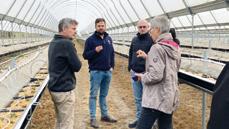
What’s involved?
Activities will be delivered in four stages focusing on different elements of the project.
Stage one
Focused on defining the characteristics of alternate substrates, including pathogen load and physical characteristics, and whether it is feasible to use these materials in commercial horticultural production. Research will be based on and build upon previous literature reviews conducted by RMCG to determine the blend of local by-products in the mixed substrate (i.e., spent coir, pine bark, sand, perlite, biochar, crushed gravel, etc.).
At the end of this stage, the project team will understand the substrate characteristics needed, the materials and sterilisation processes available, as well as which options should be explored in practical research trials.
Stage two
This stage will involve small-scale trials with spent coir and the alternative substrates identified in stage one, to formulate a mixed substrate that produces yields comparable to the current practice (i.e., new coir). Findings from this stage will determine whether a mixed substrate is economically feasible in commercial horticultural production.
It is anticipated that there will be several small-scale trials during this phase to test a range substrate mixes, with spent coir to be sourced from industry partners, then sterilised, mixed with alternative substrates,
17
L-R Stephen Welsh (Costa), Simon Dornauf and Jason Barnes (Hillwood Berries) and Doris Blaesing (RMCG) discussing recycled coir combinations at Hillwood Berries
INDUSTRY
Photo credit: Mark Salter
and then trialed on a small-scale (0.5ha per farm). At the conclusion of this stage, the most effective substrate mixes will be documented, and a comparative emissions assessment will be carried out for each substrate mix.

Stage three
The mixed substrate identified in the previous stage of the project will be trialed within the industry partner’s production systems on a commercial scale.
Throughout these trials, industry partners will collect data on several variables (i.e., yield, growth rate, pathogen profile, physical structure, porosity) to be used in the economic analysis in stage four.
This stage will determine the feasibility of the mixed substrate on a commercial scale and feasibility for adoption by wider industry.
Stage four
The final stage will involve a thorough economic analysis to compare overall production costs between new coir and the mixed substrate using the trial data collected in stage three. This analysis will demonstrate the economic costs and benefits of incorporating coir recycling into production systems.
How can I find out more?
Growers will be invited to take part in a number of interactive field days to learn more about coir recycling, the materials and processes involved, as well as the economic factors at play.
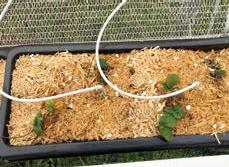
In addition, fact sheets, reports, articles and case studies will be developed throughout the project and shared through the Fruit Growers Tasmania and Berries Australia websites, this journal and industry e-newsletters.

18 BERRY AUSTRALIAN JOURNAL AUTUMN 2023 EDITION 14
Recycled coir combinations at Hillwood Berries.
Photo credit: Mark Salter
Smart Farming Guide for Horticulture
Liam Southam-Rogers & Henry Hyde, Applied Horticultural Research Project: (ST19023) Digital remote monitoring to improve horticulture’s environmental performance
What is smart farming?
Australian horticultural industries are facing increased challenges with climate variability, supply chain reliability and labour shortages. While no single measure can address all these challenges, farmers can adopt new technologies to optimise management and remotely monitor farm conditions to inform decision making.
Using sensors and technology to improve productivity and performance are at the core of smart farming, with remote monitoring of farm conditions assisting growers to use their resources more efficiently, from labour to other inputs.
This is already happening in some horticultural sectors, with trials underway that could also show promise for berry growers.
Improving the productivity and environmental performance of farming systems using sensors and technology is known as smart farming. For smart farming to work, sensors are located at various locations around the farm and remotely monitor key parameters. The data from the sensors is fed into a centralised management tool, known as a dashboard. The Hitachi Vantara Control Tower is an example of such a dashboard. In addition to the data feed from on-farm sensors, dashboards can also use models and other tools to increase the value of measured data.
Project overview
The National Landcare Program has funded four pilot smart farms in Queensland and is supporting development of the Control Tower, which provides growers with an integrated data platform to farm efficiently. The Control tower also demonstrates environmental best practice to customers and compliance bodies.
The Smart Farming Partnerships team consists of Applied Horticultural Research, Hitachi Vantara, Freshcare, Greenlife Industry Australia, AusVeg, Growcom, Australian Banana Growers’ Council and Hort Innovation.
The four pilot sites are Bartle Frere Bananas in Innisfail QLD, Golden Grove Wholesale Nursery in Torbanlea QLD and 2 separate areas at Austchilli Group in Bundaberg QLD, which hosts the avocado and vegetable smart farms. Each of the pilot farms are trialling different types of technology for their unique use needs and industry priorities. Videos from each of the four pilot smart farms are available on the AHR website at ahr.com.au/smart-farming
The suite of sensors at each pilot smart farm is designed to provide efficiency benefits and data that can satisfy remote audits of environmental management systems such as Freshcare Environmental and EcoHort.
Hitachi Vantara Control Tower
The Hitachi Vantara Control Tower is being developed to holistically measure farm productivity and environmental stewardship. The key approach to developing this system is to provide a single integrated platform that captures data from all key sensors used across a farm or nursery.
The integration of sensor data, weather forecasts and biophysical models can be collated and analysed. The data are then presented as simple user interfaces or actionable insights to enable users to make decisions regarding business operations.
Importantly, the Control Tower can also automate much of the Freshcare Environmental audit reports and provide decision support tools for managing nutrient runoff and leaching.
19
INDUSTRY
Technology
The project works with a range of technology providers that are prepared to share data from their proprietary software systems to the Control Tower, such as ICT International, Wildeye, Binary Tech, Eratos and Goldtec. Data is shared securely via the Application Programming Interface (API) standard to the Control Tower. There is a great benefit to working with companies who are willing to share sensor data because no farming business is locked into a single ecosystem, and growers retain the flexibility to select the best equipment for their needs, maintenance capability and budget.
Is smart farming right for your property?
The term “Smart Farming” covers an extraordinarily large set of tools and practices. This can add to the daunting nature of working out where to start. The Smart Farming Technology Guide for Horticulture makes this a more manageable task with its Key Considerations chapter.
This section contains a list of easy to work through questions designed to help growers determine the smart farming practices and sensors that will offer the most benefit to their business.
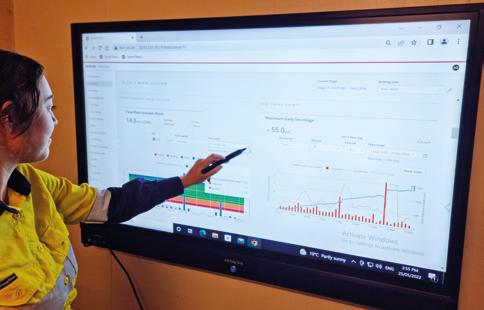
The guide also points to external references for those looking to dig deeper into the topics covered.
Shorter ‘How To’ guides will soon be available in print versions, each focusing on different aspects of smart farming. An updated version of the document will be developed later in 2023 with an additional section discussing new methods for digital reporting for environmental management systems, such as Freshcare Environmental and EcoHort.
Those wishing to learn more about the project, or smart farming in general, can do so by visiting the project website www.ahr.com.au/ digital-remote-monitoring or by contacting Liam@ahr.com.au or Henry.Hyde@ahr.com.au.
You can also join the smart farm mailing list at eepurl. com/hLsoCD to be notified of relevant upcoming events, such as webinars and workshops.
20 BERRY AUSTRALIAN JOURNAL AUTUMN 2023 EDITION 14
Control Tower in use at Austchilli in Bundaberg. Photo credit: Applied Horticultural Research
The Smart Farming Technology Guide for Horticulture contains detailed information on the technology used on the smart farms. Scan this QR code to find out more or visit www.ahr.com.au/ digital- remote-monitoring. Factsheets on each of the four pilot smart farms are also available.


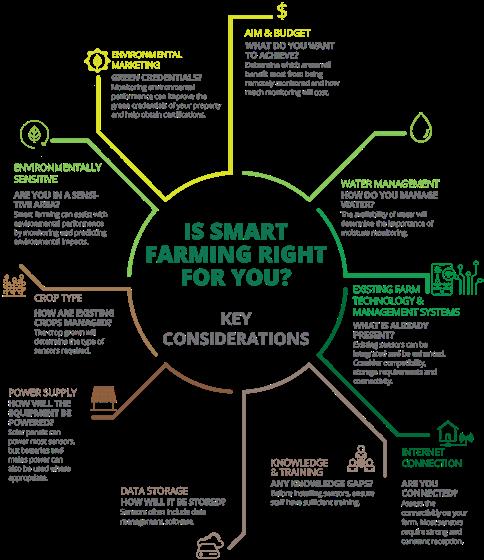
21
Case Study: Smart Production Nursery

Golden Grove Wholesale Nursery is a 2ha citrus production nursery in Torbanlea, Queensland, producing and supplying commercial growers with containerised fruit-tree nursery stock for planting in orchards. Golden Grove is a pilot smart production nursery as part of the digital remote monitoring project.
Golden Grove is an innovative operation; recent additions to the production nursery include a new smart irrigation system and a redesigned growing container (pot) for horticultural tree stock. The nursery has had a range of technology installed to monitor productivity and environmental performance.
The technology installed at Golden Grove includes:
Technology Productivity Environmental BMP
Weather Station
Smartphone & Tablet
Weight-based irrigation system
Dam monitoring (pH, temperature, depth & EC)
Drain monitoring (pH & EC)
Pest cameras
Pot leachate monitoring (volume, pH, EC & temperature)
Desktop photometer
Stem dendrometer
Potting media moisture monitoring
On-site real time weather information, such as wind and rain
Reduced time required for audit forms
Overwatering can be minimised
Improved accuracy of audit forms
Improved irrigation management Overwatering can be minimised
Improved water quality management
Improved irrigation and nitrogen management
Improved pest management
Improve nutrient/water management
Improved nutrient management
Plant stress can be monitored more effectively
Improved irrigation management
Improved release water quality
Nutrient loss to environment can be minimised
Improved pesticide management
Improved release water quality
Nutrient loss to environment can be minimised
Overwatering can be minimised
Overwatering can be minimised
Spray records are automatically populated
EcoHort records are automated
Irrigation water use is recorded
Irrigation water quality is recorded
Release water quality is recorded
Sticky trap record is automatically filled
Release water quality is recorded
Release water quality is recorded
Nutrient management efficiency is increased
Irrigation water use is recorded
Weight-based monitoring at Golden Grove Nursery.
Acknowledgements
The smart technology installed at Golden Grove is helping to optimise operations and reduce costs. For example, the potting media moisture monitoring probes have helped improve irrigation management, leading to a 30% reduction in water usage. There have also been significant labour savings in water monitoring, as the nursery is now able to remotely access irrigation water quality data. Potting media EC and leachate monitoring sensors have allowed the nursery management team to optimise fertigation and reduce excess nutrient loss.
The Smart Farming How To guide has been developed as part of the project Digital remote monitoring to improve horticulture’s environmental performance (ST19023) funded through the Australian Government’s Landcare Smart Farming Partnerships program with contributions from the Vegetable, Nursery and Banana levies and delivered through Hort Innovation.
22
Photo credit: Applied Horticultural Research






23
Tasmania: Berry Sprayer Field Day
 Mark Salter, Berry Industry Development Officer, Fruit Growers Tasmania & Dave Farmer, Croplands
Mark Salter, Berry Industry Development Officer, Fruit Growers Tasmania & Dave Farmer, Croplands
With Blueberry rust declared endemic in Tasmania and mandatory control restrictions on Blueberry rust now lifted, a number of organic or lowinput growers are having to use sprayers and develop protective spray programs for the first time. To help these growers get up to speed on sprayer technology, Fruit Growers Tasmania, Berries Australia, and the Tasmanian Institute of Agriculture held an Orchard sprayer field day on 23 November 2022 at Millers Orchard in Hillwood, Tasmania.
Attendees had the opportunity to discuss the relative strengths and drawbacks of different sprayer types, with three demonstration units also available for attendees to see in action; a Carraro™ sprayer designed for smaller berry growers, a small self-propelled MM® tunnel sprayer, as well as a larger 1500L Cropliner™ (Airblast) sprayer towed by a Kubota tractor.
Stuart Farrell from Sprayer Solutions demonstrated the Carraro™ unit which has its own petrol driven power plant and can be towed along by an ATV, whilst David Lindley from TASMAC demonstrated the MM® self-propelled unit which is primarily designed to spray the leg rows in poly tunnels but would be ideal for smaller growers.
Both the smaller spray units were demonstrated in the field giving growers an idea on their coverage and general performance. Note: Only water was used in the demonstrations.
Presenting on the day was Dave Farmer from Croplands, who travels the country advising growers on how to maximise the effectiveness of spray units for their specific crop. In his presentation, Dave talked attendees through how to match sprayer setup to the crop, how to calibrate the sprayer and check for suitable spray coverage and how to manage spray drift.
Sprayer setup
When setting up a sprayer, matching the sprayer setup to the crop is very important to ensure most of the spray hits the target crop without being be forced through the crop and on to surrounding crops or vegetation. To achieve this, growers should choose the correct nozzles for the job and focus on fan speed to supply the optimal air velocity and volume. This is particularly important for berries, as excessive air velocity may damage the crop.
24 INDUSTRY BERRY AUSTRALIAN JOURNAL AUTUMN 2023 EDITION 14
Dave Palmer from TASMAC demonstrating the MM® self-propelled unit. Photo credit: Fruit Growers Tasmania



25
The self-propelled MM® tunnel sprayer unit that may suit small berry operations.
Photo credit: Fruit Growers Tasmania
CALCULATING WATER + CHEMICAL QUANTITIES
CHEMICALS REQUIRED (Litres or Kg) PER HA
AREA COVERED (HA)
TANK VOLUME OF MIXTURE REQUIRED (Litres)
CHEMICALS REQUIRED (Litres or Kg)
IMPORTANT
BE SURE TO MIX ONLY ENOUGH SPRAY MIXTURE TO COVER THE AREA REQUIRED. AVOID WASTAGE AND PROBLEMS OF NEEDLESS CHEMICAL DISPOSAL.
26 BERRY AUSTRALIAN JOURNAL AUTUMN 2023 EDITION 14
Tank Volume (L) x Recommended Chemical Rate (L/ha) or (Kg/ha) Spray Application Rate (L/ha) EXAMPLE 3000 Litres x 5 (L/ha) ÷ 900 (L/ha) = 21.4 Litres or (Kg)
Tank Volume (Litres) Spray Application Rate (L/ha) EXAMPLE 3000 Litres ÷ 900 (L/ha) = 3.33 hectares
Area (ha) x Spray Application Rate (L/ha) or (Kg/ha) EXAMPLE 3.25 (ha) x 900 (L/ha) = 2,925 Litres
Tank Volume (Litres) x Recommended Chemical Rate (L or Kg per 100 Litres) 100 EXAMPLE 1500 (L) x 3 ÷ 100 = 45 Litres
Graphic produced with thanks to Croplands. Find out more www.croplands.com/au
Before spraying it is necessary to calculate the exact quantities of water + chemical needed to spray the required area of orchard.
Calibration
Once set up, growers should calibrate the sprayer to their production area. Regular calibration checking is also a requirement for any of the food safety certification schemes.
The typical calibration process is completed in 4 steps:
Step 1 Clean the unit
• Ensure there is no residual chemical in the tank
• Check that the nozzles are clean, not blocked and set correctly
Step 2 Check speed
• Half fill the tank with water
• Measure out 50 or 100m and time how long it takes to travel that distance
• Include uphill and downhill if you have a sloping block
• Calculate the km/min travelled by the machine
Step 3 Calculate total sprayer output
• Run both sides of the sprayer at normal pressure
• With 2 people + 2 jugs + timer + calculator, use the jug to capture output in 1 minute from each nozzle and combine to calculate the total L/min from the whole unit
• Ensure that you use the correct PPE to protect eyes, ears and skin
Step 4 Calculate L/ha output
• Using row width, total L/minute from the output calculation in Step 3 and speed from Step 2 you can calculate the L/ha output
Managing Drift
Spray drift was highlighted as a growing issue for the industry from both a regulatory and public awareness perspective. Dave provided numerous examples of spray drift reaching adjoining farms and property resulting in costly fines, and product becoming contaminated and unable to be marketed.
Late in 2022, a large-scale spray drift event hit up to 30,000 hectares of cotton on the eastern Darling Downs causing up to $100 million worth of damage.
Read more at https://ab.co/3jwjD5H
Spray drift can be caused by spraying when winds are too high or by having fine or very fine sized droplets that can be carried beyond the target crop and on to neighbouring vegetation or crops. Dave noted that key factors contributing to the formation of these droplets are pressure, nozzle type, the use of some adjuvants and simply not having machines set up correctly.
He also spoke about the benefits of air induction nozzles which are designed to deliver droplets to the target and not into the atmosphere.
Key considerations for managing spray drift include:
• Calibrate your spray unit and assess coverage before the start of the season
• Increase droplet size and use low drift nozzles
• Reconsider the use of wetters and particularly avoid non-ionic surfactants
• Keep detailed spray records and critical weather data particularly wind speed and direction at the times you are spraying
As Dave pointed out, keeping accurate records of spraying and accompanying weather data is not just a requirement for your food safety compliance program, its more and more possible that you may need to be able to produce your records for scrutiny if you end up in a legal battle from a spray drift issue.
Thank you to Croplands and Nufarm for your support of this Field Day.
27
The future of berries: Are we doing enough to meet technology half-way?
Jen Rowling, Project Manager, Berries Australia
At BerryQuest 2022, Jesse Reader, Commercial Manager for Ag Technology & Innovation at Costa Group gave a great presentation about how industry needs to step up to meet the new technology coming along if we want to see faster progress in the AgTech space. For those that missed his talk, this article summarises Jesse’s presentation.
The world of AgTech has boomed over the past couple of years. During the pandemic, money stopped flowing to millions of businesses and into most parts of the world but this was not the case for AgTech.
AgTech has previously been highly focussed on farm-centric hardware and software technology, but recently investment has shifted into agrifood technology. In 2021, $32.1 billion of the $51.7 billion invested in AgTech has been directed downstream into agrifood tech. The AgTech lens has essentially been stretched to include such diverse areas as provenance, traceability, and food delivery systems.
An example is a $3 billion e-Grocery AgTech deal done in 2021. This stretch of investment presents an 85% increase from 2020 and it’s exciting to see the continuing flow of funds coming into the AgTech sector.
What’s even more exciting is that the global berry industry hasn’t missed out.
• A vertical farming startup, Oishii received $50 million for bee-assisted carbon neutral strawberry cultivation
• A collaboration between Driscoll’s and Plenty in the vertical farming space continues to evolve with the addition of a $140 million investment
• Bowery Farming, the largest vertical farming company in the United States, has acquired Traptic, a company utilising computer vision, robotic arms and artificial intelligence (AI) to harvest fruiting, vine and other delicate crops, including strawberries
Despite the investment in AgTech and the companies out there that are working on this incredible technology, there is still an element of scepticism from our sector. The broader industry in Australia continues to question the validity of the technology being developed, whether it will work here, what it doesn’t do rather than what it does or could do, what it should be able to do but doesn’t yet and how long it is going to take! A very glass-half-empty attitude.
28 INDUSTRY BERRY AUSTRALIAN JOURNAL AUTUMN 2023 EDITION 14
What can we as growers and as an industry do to meet the technology companies half-way to achieve what we need for our industry?

Data
All roads lead to data! If we’re not collecting robust, reliable and meaningful data sets, access to technology becomes very challenging. There is considerable technology that we can’t actually use until we are able to build deep data sets.
Environment
What can we do to remove variability? In harvesting, for example, we have to think about all the things that technology companies are trying to do that we haven’t been able to overcome. These are things like controlling light and evening out maturation of fruit; the more consistent the maturing of fruit for harvest the easier it becomes to introduce the tech by taking the discretion out of selecting fruit for harvest.
Connectivity
Technology requires connectivity. Wireless updates and even the ability to do support and maintenance of technology remotely require reliable connectivity. When something goes down and its tech-enabled, what will Tier 1 support look like? Will we be able to resolve problems over the phone rather than over the air? Machine-to-machine communication also requires connectivity. Technology such as automated sprayers, fully automated tractor kits, electric selfdriving tractors and advanced robotics is all coming through, but autonomy needs supervision via someone with a tablet supervising the fleet. All this requires connectivity. There are no real excuses now (with some exclusions of course!) but there are some fantastic solutions in this space to ensure consistent connectivity to support the technology.
29
Varieties
In the development of new varieties, we should be thinking at least ten years ahead. What does a piece of fruit need to look like, how does it present on the plant and how firm does it need to be for a robot to be able to select and handle it whilst maintaining the integrity of the fruit during harvest?
There are considerable traits that need to be considered and plant breeders need to be working to incorporate these traits into the plant genetics in alignment with the tech companies developing the robotics. This will go a long way towards achieving the robotic harvesting needs of the industry.
Two-Way Engagement
If you want the solutions to come to you quicker, start working with the solution providers. Articulate the unmet needs that you have and help them to understand which part(s) you need a solution for. You will then develop a mutual acceptance of the limitations around what you are trying to do, and things can then move quicker. Rather than sitting and waiting for the solutions to magically appear why not co-create the solution by actively engaging and discussing, and understanding what can be achieved.
Plant Architecture
If we sat down to solve the harvest problem as a design exercise, with all blinkers off and using critical thinking, we may not grow the way we currently grow.
We are not meeting tech half-way in regard to plant architecture. We need Simple, Narrow, Accessible, Productive (SNAP) canopies. It doesn’t matter which crop we’re talking about; the aim is to present the fruit in a purposeful way.
What is your current production system optimised for?
Is it yield; is it quality? Will we get to a point where it will be optimised for accessibility for robotic harvesting?
Lower planting density may be more viable for robotic harvesting, more berries per plant but fewer plants perhaps. These are the things to consider if we are to meet the technology half way. Again, it’s also about removing the discretion associated with harvesting fruit.
People
A business needs to start the conversation and build inhouse capability around new tech coming in prior to its arrival. The introduction of new tech can cause issues with integration and embedding into the business. The technology discussion is like a different language, it’s not native to most and starting the conversation and capability development prior to the introduction will help soften the landing when the tech actually arrives.
The introduction of new tech into a business also means getting comfortable with ambiguity! Life isn’t black and white, it’s grey and the tech isn’t always perfect. It won’t do everything you think. Get comfortable in the grey area and with some critical thinking, great things will happen.
Investment
None of this tech will eventuate if we don’t invest in it. If these things are as important as we think they are, then we need to back it by investing properly and consistently.
The beauty of becoming technology-ready, even if the robots aren’t marching in, is that your business will be better for it. More productive, better packhouses, improved safety – all these initiatives to meet technology are a good incentive for business improvement so you can’t lose by doing it.
Key messages
Be comfortable in the grey area. We get taught in black and white. The world is grey.
Reframing preconceived notions in an opportunistic way can help eliminate the logic of “the way things were” and get to “what could be”.
Expand your time horizons; 3 years out seems like a long time but its likely less than 10% of your working life. Think 10 – 15 years out instead when it comes to things like how a technology could impact you.
Technology is a move from conventional to analytical, whether we like it or not.
To meet the challenge half way we must pair critical thinking with emerging technologies to create safe, productive and efficient farms that produce high quality fruit with high market desirability.
30 BERRY AUSTRALIAN JOURNAL AUTUMN 2023 EDITION 14
Jesse Reader
Born and raised in country Tasmania, Jesse has a deep appreciation of the issues and challenges faced by the agricultural sector.
Jesse graduated from the University of Tasmania with a Bachelor of Applied Science (Agricultural). He worked for ten years across a range of cropping systems as a production agronomist, where he focussed on perennial horticulture and technology transfer.
As Technical Manager for Apple and Pear Australia (APAL), Jesse was pivotal in driving significant productivity and quality gains for the industry via international knowledge transfer and extension. During his time at APAL Jesse was awarded the industry impact award for his work on the Flagship ‘Future Orchards Program’.
During the last five years, Jesse has been at the forefront of agricultural technology development, thought leadership and industry engagement. In 2020 Jesse completed a five-year, international business opportunity analysis of AgTech at global giant Robert Bosch.

In 2021, Jesse took up a role at ASX Listed - COSTA Group. Jesse's current role as Commercial Manager - AgTech & Innovation, sees him applying new technology and innovative approaches to emerging and existing business needs.

Asia Fruit Logistica: Reflections on the Thai market
Jenny Van de Meeberg, Export Manager, Berries Australia
In November 2023, Berries Australia led a delegation of berry growers to Asia Fruit Logistica (AFL) in Thailand. Berries Australia ran an ‘Expression of Interest’ process to award six partially-funded places for the visit. We were pleased to be joined by berry growers from each category (blueberry, strawberry & Rubus) and from a variety of locations across Australia including QLD, VIC, NSW, WA, and TAS.
After returning from Asia Fruit Logistica, these berry growers were asked to share some of their reflections from the trip with the broader industry. If you have any questions about Asia Fruit Logistica or export, please contact Jenny Van de Meeberg at export@berries.net.au
Can you describe the difference (real or perceived) between Australian product and competitor product?
There was a real difference in how Australia markets their fruit in Asia vs what we see from other parts of the world. It may have been the timing of everyone’s harvest globally; however, you could see some major differences.
Premium vs Standard
It was interesting that Australian producers have focused on larger pack sizes for premium fruit in Asia.
Premium Fruit
Australia has realised that the only way to compete with lower-cost producers is to create a product worth paying more for. In addition, they had a couple of brands that aren’t available in Australia from the same grower being marketed side-by-side.
Standard fruit
From the limited fruit I saw in the market visits and at the show, countries like Peru and Chile were in 125g punnets. Retailers were using lower-grade products as “entry-level” and at significantly cheaper retail price points. Also, retailers were “bundling” punnets together in a larger offer with tape. A larger pack size may reduce the need for additional handling. Around the show
Around the show
I felt there was a real lack of theatre with the fruit (specific to berries) available at AFL this year. It may have been due to Thailand's biosecurity requirements, which can be harsh on fruit. However, in shows in Hong Kong, we found a lot more fruit available from various countries/continents. Packaging innovation was really lacking at the show, with “plastic” still being central to berry production in Asia, which was a little different to what we saw in 2019 in Hong Kong.
32 INDUSTRY BERRY AUSTRALIAN JOURNAL AUTUMN 2023 EDITION 14
NSW GROWER
I think Australian product has a perception of a higher quality product particularly related to freshness and flavour. I think our growing techniques are known to be highly regulated and as a result they are trusted to be safe and healthy.

What was the most novel/interesting/effective use of marketing/ packaging you saw at the show or in the retail stores?

I really liked the rockit™ apple and the Premium blueberries by OzBlu in the cylinder as well. "I would not like to have to pack the fruit in them, but they presented really well.

I really liked Rockit™ New Zealand Apples. I thought their focus on small snack size apples was innovative and unique when most people in their category focus on bigger is better. The tube packaging also made the product present well and set them apart on shelf. OZblu blueberries also looked great, and I loved their premium tube packaging for blueberries.

33 WA GROWER
OZblu blueberries (from Peru) and rockit™ apples in clear cylinder packaging.
VIC GROWER
TAS GROWER
Berries were generally presented in the standard 125g plastic clamshell punnet. We saw Australian, South African, Peruvian and Mexican fruit presented in the standard 125g punnet; albeit with varying dimensions. Jumbo Australian blueberries were for sale in a high-end supermarket in 200g punnets. In the same retail store, a small quantity of French blueberries was found in 100g cardboard punnets placed inside a plastic punnet (presumably in-country).
At Makro supermarket, Peruvian blueberries were offered as 500g and 1kg punnets. Presentation of blueberries in standard supermarkets was typical of any Australian supermarket. Fruit was placed in open refrigerated displays. Presentation of blueberries (and all other produce) was very impressive at the higher end supermarket. Display stands were varied in produce and all was displayed in a very appealing way.
One trade stand at AFL was offering cardboard manufactured punnets/trays/produce carriers which will see more take-up as the move away from plastic packaging increases.

The one thing I did note that I thought was interesting was the amount of “pre-cut fruit” available in retail stores looking to “value add” and minimise consumer waste. Due to the country's socioeconomic conditions, the need to reduce food waste in Thailand seemed to be more important than environmental waste. A good example is the “coconut” wrapped in plastic with marketing and attached to a drinking straw. I can see the marketing appeal; however, it seemed unnecessary for the product, except that they were marketing it directly at children.

34 BERRY AUSTRALIAN JOURNAL AUTUMN 2023 EDITION 14
Blueberries packed in cardboard punnets re-packed into plastic punnets.
Wrapped coconuts.
NSW GROWER QLD GROWER
Please describe the key features of the retail sites visited – did anything strike you as different/interesting/unique compared to Australian retail?
What was most striking was that retail is so similar to what we see in Australia in terms of presentation. The product mix in produce was obviously different in several instances. A key feature that struck me was how much single use plastic is being used – which was disappointing if this is the trend direction. The quality of berries on display was mixed – regardless of which tier of retailer we visited. I assume this is a reflection of the distance/time taken for delivery of the product and the treatments required to get the product into the country.
Pricing in the berry category was more expensive than in Australia but when you factor in all the costs of logistics and all the stages in the supply chain, not too surprising.
Lotus’s/Big C/Makro

The fresh produce sections at these stores were located at the rear of the store or upstairs (Makro). The produce looked to be good quality and resembled a typical Australian supermarket. I noticed a greater amount of fresh, leafy greens loose in some stores in comparison to at home.
Imported products tended to be promoted as such and sometimes in their own sections with other imported lines.

35
Various loose leafy greens in a Supermarket. Imported produce sections in Supermarkets.
QLD GROWER
VIC GROWER
Gourmet Market
This store was a high-end supermarket and fresh produce was at the front of the store. Produce was beautifully presented on round island displays with a combination of different products. The beauty and visual appeal of the displays were inviting and impressive. Berries made up some of the produce displayed in these sections.
Pre-packaged sections were comprehensive and produce was displayed in refrigerated cabinets where all product was pre-wrapped in plastic. The amount of plastic packaging of the produce in this store was very high.
This store also had a dedicated section for imported produce where the country of origin is promoted including Australian product.

For berries (specifically blueberries) to become a much bigger category in Thailand, we need to produce fruit with a long shelf life that can handle temperature fluctuations. Most Australian production would not be suitable for this purpose, but better genetics are coming through that will improve the availability to cool chains. For this specific reason, raspberries and blackberries will be difficult products to market in this country as the product is very sensitive to humidity and heat.
On the flip side, strawberries which are as sensitive as Rubus, have managed to find a way to supply Asia. This involves a specific style of harvest and berry that would not meet Australian retail specifications. However, since the shelf life is more important than sugar content for sales, it has successfully made a market in Asia, which we saw in stores whilst we were there. In fact, we only saw strawberries from Western Australia in most stores we visited.
The last store that we visited, “Gourmet Market” had a very different style of trade which I thought was very interesting and not a model that you see in Australia. In-store, there were three specific areas for premium fruit, and all of them had slightly different offers from the others, in terms of brands, sizes and quality. This was due to each of the smaller stands independently sourcing fruit for their displays, and they managed the stock directly, and the store would take a percentage commission on the sale. I found this extremely interesting as the owners created a lot of theatre and excitement around their displays to ensure that they attracted more shoppers. This is a very different model from what I have seen for fruit and vegetables and is strikingly similar to the “Best Buy” electronic retailer in the US.
The different tiers of chain supermarkets seemed quite pronounced. The high-end supermarket we went to was very impressive and the produce was of a much higher level in quality and in price. It was also interesting in some of the higher end chains that the shelf space was basically ‘rented out’ for fresh produce like department stores in Australia. This means you had multiple displays with the same produce. I believe this makes it particularly important for Australian exporters to partner with the right importer that will present fruit well in the right supermarkets.
36 BERRY AUSTRALIAN JOURNAL AUTUMN 2023 EDITION 14 QLD GROWER
Imported produce section in Gourmet Market Supermarket
NSW GROWER
TAS GROWER
Elite Tunnels is an established British manufacturer and global supplier of field-scale multi-span polytunnels, substrate gutter growing systems, and ancillary parts.
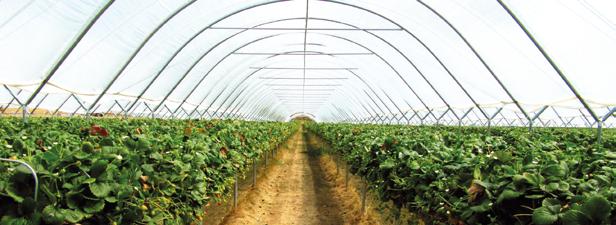


For projects of any scale, our familyrun business will professionally handle your order – with a personal touch!

We hold stock of a variety of ancillary parts, including:




C-clips • hinge-clamps

sheeting-rope • rope-pullers

We also stock ample rolls of plastic.

We are proud to be associated members of: Our materials are proudly UK and EU sourced. www.elitetunnels.com Ross Watt ross@elitetunnels.co.uk Mobile: +44 (0) 7841 532 652 Office: +44 (0) 1356 648 598 Australian agent James Downey jdowney@polygro.com.au Mobile: 0400 893 250 Office: +61 2 9502 6000 WE’VE GOT YOU COVERED
Visit our NEW website to see details of our products and view drone footage of our Australian polytunnel projects!
Area wide pest management — an essential approach to fruit fly management
Bronwyn Koll, Queensland Fruit Fly Regional Coordinator, Agribusiness Yarra Valley
• Area Wide Management (AWM) is a common phrase heard when discussing prevention and control of fruit fly
• The fruit industry is encouraged to use AWM to reduce fruit fly pressure in production systems
• AWM requires the concerted effort of all land managers in a region to be effective
• Achieving this level of co-ordination in a region takes time, resources, planning, money, and most importantly, industry guidance
The Yarra Valley QFF program’s greatest achievements using AWM techniques
The Yarra Valley has adopted many QFF AWM techniques. The Yarra Valley QFF prevention and awareness program (funded by Managing Fruit Fly in Victoria 2015-2020 and Victoria’s Fruit Fly Strategy 2021-2025) supports a trapping surveillance grid for early detection, and QFF awareness activities with the general public (community workshops, emergency response, fruit fly ID, and informative articles in print and on social media).
Achievements include:
• Yarra Valley resident’s raised awareness about QFF. This message has also been extended over metropolitan and peri-urban Melbourne where there are home gardens with QFF infestations.
• Isolated QFF cases in the Yarra Valley have been detected early and reported to the program’s funded Regional Co-ordinator.
• Cases have then each been rapidly responded to, promoting local action resulting in area wide benefit.
Affected land managers have been pre-prepared in the lead up to QFF being detected and have received 1:1 mentoring in control, management and prevention activities.
• Other land managers in the wider region have been notified through various communication networks, allowing individuals to each increase their own level of preventative action on their own properties.
The good news story is that QFF detections in the whole of the Yarra Valley have remained very low each fruit season (since the initial 2018 discovery of QFF). Given the rapid spread and establishment typical of QFF in other areas, mitigating the impact immediately has had large scale positive effect for the typically QFF free region. Delimiting activities have demonstrated that these cases have not spread past the area of concern, despite favourable QFF conditions.
This is supported by a high rate of action (baiting, trapping, fruit treatment and host crop removal) taking place amongst land managers. Ongoing surveillance and rapid response support in the years to come can help to preserve this.
38
BERRY AUSTRALIAN JOURNAL AUTUMN 2023 EDITION 14
INDUSTRY
Protecting more than just fruit from QFF

Integrated pest management (IPM) of other pest insects in production systems has been preserved and improved. Producers have installed an increased number of sticky traps, and whilst looking for QFF, production managers are now more aware of other pest insects compared to earlier scouting methods used. A major benefit of not having to control QFF with broad spectrum cover sprays is the protection of systems that use biological predators to manage pests like Western flower thrip (Frankliniella occidentalis), a pest that does not have a chemical control alternative. In regions with high QFF pressure, some biological pest control programs have been ditched. Production systems are solely reliant on chemical control of other pests and on cover spray techniques for QFF management. The Yarra Valley is in a strong position going forward in IPM adoption if QFF remains a minor or zero threat regionally.
There are efficiencies and benefits when growers work together on QFF AWM in a region, including the early detection and rapid response program, the alerts and de-identified data sharing, and the efficiencies of delivering a centrally run regional surveillance network. The future use of a coordinated surveillance network extends into regional readiness for using sterile insects and other emerging technologies for QFF management in the future.
Sustainable funding into the future
In general, the export of fruit (including berries) out of a region like the Yarra Valley can help increase and regulate the domestic prices for all fruit. Often, surveillance programs linked to export protocols combined with QFF action and prevention activities are of benefit to everyone, reducing QFF risk and pressure each season.
Industry discussion is crucial to ensure that QFF AWM outcomes are achieved in regions, States and across the country. What is the value of the QFF AWM program to local fruit productivity and biological systems? How it could be possibly achieved with alternative means or alternative funding sources? Each region will have multiple pest management focuses, different crops, and different QFF pressure, and lessons can be learned from how other regions and other fruit industries have or haven’t dealt with the issue. How can small regions equitably fund local QFF AWM action sustainably into the future?
Moving forward, the fruit fly program in the Yarra Valley will have to prioritise which activities are able to be delivered on a reduced budget if program funding declines. There are options to investigate co-funding, or in-kind contributions to the project if on-farm surveillance activities are all co-ordinated and linked.
To contribute your ideas for the future of regional QFF AWM in the Yarra Valley contact:
Bron Koll, Yarra Valley QFF Project Co-ordinator
qff@agribusiness-yarravalley.com
0490 381 999
OR
Your Berries Australia Industry Development Officer
Your experiences and thoughts will be valuable to prioritise action and ensure value from the program.
Area Wide Management information
Plant Health Australia and Hort Innovation have further resources on Area Wide Management: Area-wide management of Queensland fruit fly and using sterile insects
www.farmbiosecurity.com.au/area-wide-managementof-queensland-fruit-fly-and-using-sterile-insects
Area Wide Management
www.preventfruitfly.com.au/controlling-fruit-fly/ producers/area-wide-management/
Hort Frontiers Fruit Fly Fund Strategic Partnership Initiative
https://area-wide-management.com.au
39
Bron Koll providing information at a local event in the Yarra Valley. Photo credit: Agribusiness Yarra Valley
Recovery & Resilience: A Berries Australia & Hort360 Project
John Hay, Industry Recovery & Resilience Officer, Berries Australia
It is no secret that we live in a volatile and changing climate, and that the last few years have been challenging for the horticulture sector seeing both extreme drought and flooding events. At an industry level we can’t stop these events from occurring, although we can ensure that our growers have the tools and well-developed resilience to deal with the resulting challenges when they occur.
Resilience can be defined as ‘the psychological capacity to adapt to stressful circumstances and to recover from adverse events’. In that sense, the best way to develop resilience is unfortunately through experiencing and surviving hardship, as difficulties can strengthen the mind provided it coincides with the right support.
A key focus for Berries Australia is to build industry capacity to enable better preparedness, and to foster the ability to recover quickly, and so empower growers to become more resilient in the face of future events.
The Recovery & Resilience project has a broad remit, but two areas where significant gains can be made are through practice change in on-farm efficiency and diversification to reduce risk.

Efficiency gains can increase the profit available for investment into projects that aid recovery and boost resilience. Through the delivery of project information that meets the changing regulatory space, we hope to inform growers so they can adapt to change and at the same time improve the triple bottom line looking after profit, people and the planet.
Diversification on farm can offer additional income streams at times where the main enterprise might suffer. In some cases, it is hard to value diversification projects but they can provide a resilience buffer against issues such as drought, erosion and run-off, and help to improve biodiversity. Through practice change, we can help growers to move away from ‘path dependence’; an economic and social science phenomenon whereby history matters i.e. what has occurred in the past persists because of the resistance to change (Figure 1).
40 BERRY AUSTRALIAN JOURNAL AUTUMN 2023 EDITION 14 INDUSTRY
PATH DEPENDENCY
Photo credit: wallstreetmojo.com
To begin this process, Berry growers in the NSW regions of Northern NSW and Coffs Harbour will have the opportunity to undertake a facilitated on-farm assessment using the Hort360 tool to identify areas of their business that might benefit from improvement. Once a module has been completed a report is provided showing actions to take with links to information and resources. Although all modules will be available to growers, the focus will be to complete these five modules:
2. Energy
3. Irrigation
4. Run-Off
5. Pesticide
With the focused modules in mind there could be opportunities to improve business planning, energy efficiency and technology adoption, spray applications and biodiversity, drainage plans and nutrient capture, and water use efficiency.
The project has employed two Recovery and Resilience Officers, John Hay based in Coffs Harbour and Steve Norman in Wollongbar to help facilitate the process. John is a qualified Distribution electrician and has a degree in Horticulture. After working in mining, gas and renewables as an electrician he was a natural fit with the Queensland Farmers Federation working on projects in Energy, Digital Smart Farms, Soil and Carbon for Agriculture, writing many technical case studies and news stories on these topics. He has experience in Macadamia production working as an agronomist's assistant undertaking soil sampling, writing nutrition plans and monitoring for insects and disease.
Steve's goals are to improve social, economic and environmental aspects of Agriculture and currently works as the Subtropical Horticulture Industry Development Officer for the Department of Primary Industries. He has experience in Winemaking and Viticulture and as an Extension Agronomist researching alternate plant varieties within sugarcane fallow crops, multispecies interrow companion planting, and investigations into different ways to capture and measure sediment runoff. Further research initiatives include testing the efficacy of silicon amendments' to increase Lady Finger Banana’s tolerance to Fusarium oxysporum.
What is Hort360?
Hort360 is a computer based, risk assessment tool, which is designed to give you a 360 degree view of your farm business operations. Hort360 assists you to identify potential risks, capitalise on business opportunities and highlight unnecessary farm expenses. It is a whole of farm business approach.

Hort360 allows the industry to be guided by science to make decisions that work for farms and businesses. It also allows the horticulture industry to demonstrate our stewardship of the environment and willingness to protect the very land we farm on.
The program is entirely voluntary. Through a oneon-one facilitated process, you will be asked a series of questions relevant to your business. As you answer each question, the system tells you if you are ‘below’, ‘at’, or ‘above’ the industry standard for each practice. If any practice is below the industry standard, you will be advised on what necessary actions are required to reach the right level.
By participating in Hort360 you will have the opportunity to access technical support, onfarm training, and professional networks. All this will enable you to increase efficiencies, reduce costs, improve productivity and product quality.
Find out more at www.hort360.com.au
To find out more information or to register for Hort360 contact us at:
John Hay 0488 147 800 recovery@berries.net.au
Steve Norman 0432 680 532
steven.norman@dpi.nsw.gov.au

41
1. Better Business


INTERVEN E ®
National Agricultural Plastics Stewardship Scheme – Update
Dr Anne-Maree Boland, RMCG & Scott Wallace, Growcom
This project aims to develop an agricultural plastics stewardship scheme for nonpackaging plastic waste. The scheme will facilitate and incentivise a viable market to recycle agricultural plastics. It will involve solutions for on-farm retrieval, from farm collection logistics, processing technology and equipment and development of recycled plastic products and their markets. This project is one of 24 funded under the National Product Stewardship Investment Fund and a key initiative of the National Waste Policy Action Plan. It is being implemented from January 2021 to March 2023.
• The project is progressing well with the completion of pilot projects in Victoria and Queensland at the end of October 2022
• We are currently reviewing how the pilot projects performed and will undertake further plastic and agriculture industry consultation to inform the broader scheme design, which will complement existing and emerging agricultural product stewardship schemes
• The scheme design components will include recommended governance, administration and funding arrangements through a proposed voluntary levy based on the weight of plastic put on the market
• The scheme operation components will cover retrieval, collection, transport and logistics, re-processing, communication, education and marketing, as well as research and development
• The implementation plan for the national scheme will be submitted to the Australian Government in March 2023
Our Approach
The RMCG and Growcom project team approach includes whole supply chain engagement throughout the development of the scheme via a representative Project Reference Group and extensive consultation with industry stakeholders. This engagement aims to harness current efforts, address barriers and facilitate practical solutions for implementation of a Product Stewardship scheme. The final recommendations for the scheme will include plastic material definitions, protocols for quality assurance, governance and operational structure, including levy and funding arrangements.
Key findings:
Victorian and Queensland Pilots
We have consulted extensively with the plastic and agriculture industry, existing product stewardship scheme operators and local government to determine the scale of the problem, explore the feasibility of potential recycling solutions, and undertake collection and logistics trials. Over 470 unique stakeholders around Australia and internationally have been engaged through the project to date. The Victorian pilot addressed the problem of protective film and drip irrigation plastics in large waste producing areas associated with intensive horticulture and broadacre cropping.
The objectives of the pilot were to:
• Improve coordination in collection and recycling table grape covers and understand the costs
• Improve on-farm retrieval, bundling and size reduction of irrigation drip tube and associated transport cost efficiency and recycling
• Improve on-farm retrieval and collection of grain silo bags and understand the costs
• Recover and recycle approximately 2-5% of the total 10,288 tonnes of agricultural plastic waste in the pilot region, equating to 200-500 tonnes.
43
INDUSTRY
The Sunraysia and Loddon regions were selected to pilot an approach to improve the collection and recycling of selected plastics due to the intensity and diversity of agricultural production.
The Victorian pilot was successful in providing invaluable operational insights and cost metrics on collection, pre-processing, transport and logistics, and re-processing to inform the broader scheme design. The pilot directly collected and recycled approximately 80 tonnes of irrigation tube and grain bags over six-months from May to October 2022 that would have otherwise ended up in landfill or contaminated the environment through incorrect disposal on-farm, such as stockpiling, burying or burning.
Farmer participation and supply chain engagement was strong. This built on early and regular involvement of the 22 partner organisations in the design of the Victorian pilot and clear and accessible resources and communication products provided to farmers and the agriculture industry.
Materials included fact sheets, plastic retrieval instructions and Frequently Asked Questions (FAQs) complemented by media releases distributed through both online and traditional communication platforms. More than 40 print and online articles and radio interviews on the pilot were conducted over the 6 months.
Providing a range of options of strategically located permanent and temporary/pop-up collection sites was important to engage farmers. The pilot raised awareness of the importance of agricultural plastics recycling with 36 farmers participating in the pilot. It greatly improved their understanding of how plastics should be prepared for collection, as evidenced by farmer adherence to standards when presenting material for recycling.
Pre-processing is integral to reducing the size and minimising contamination of agricultural plastics prior to transporting. Access and use of pre-processing
infrastructure, particularly mobile and stationary balers, is extremely limited. This resulted in reduced transport efficiency and increased costs of plastics in the pilot.
The 57 tonnes of irrigation tube collected as part of the pilot is currently being recycled predominately into plastic pellets to make new irrigation tube, while the 24 tonnes of grain bags were recycled into street furniture, fence posts and bollards.
The strength of the partnerships in establishing and running the agricultural plastics pilot in the Sunraysia and Loddon regions was integral to its success.
To help the horticulture industry address a range of agricultural plastic disposal issues, the Queensland pilot aimed to connect with growers and other recycling industry participants to facilitate more waste material being recycled in the future. One of the key barriers to recycling is the mixing of different plastic waste streams, particularly plastic mulch and drip tape.
This pilot aimed to gain an understanding of the types of on-farm retrieval methodologies and plastic quality specifications. On-farm assessments allowed the pilot to review and document the cost and time implications of current retrieval methods to test barriers to recovering plastic mulch and drip tape separately on horticultural farms.
The pilot targeted the high-producing vegetable and strawberry regions of Stanthorpe, Sunshine Coast (Wamuran), Bundaberg and Bowen Burdekin.
On-farm retrieval data was collected across multiple sites in a consistent way using a standard Field Data Collection Sheet. The benefit analysis presented a broad range of costings for retrieval and disposal of mixed plastic mulch and drip tape bundles. Of particular concern is the level of organic material contamination being exported off farm.
The project team developed a Standard Operating Practice (SOP) for the retrieval of drip tape and plastic mulch for the purpose of recycling. Due to the
44 BERRY AUSTRALIAN JOURNAL AUTUMN 2023 EDITION 14
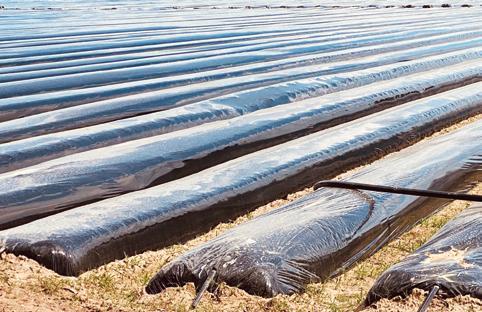
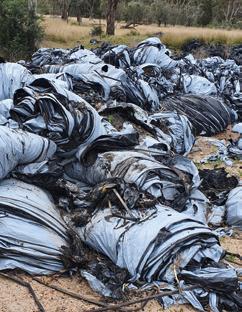
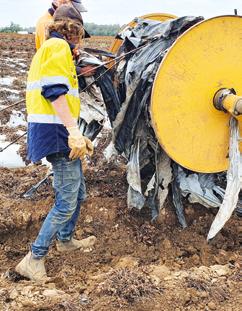
45
Current in-ground growing practices for strawberries produce large amounts of waste each season.
Photo credit: Jane Richter
Plastic mulch retrieval and source separation is a key issue for Queensland growers.
Photo credit: Brock McDonald & Scott Wallace
variability in equipment used for retrieval of drip tape and plastic mulch, there are significant differences in the quality and format of material supplied to the collection point.
The SOP attempts to address this variance by providing guidance for on-farm retrieval of drip tape which can be effectively recycled. The SOP will be published and distributed to growers, recyclers and other industry members by Growcom to continue to raise awareness of meeting standards during on-farm retrieval of agricultural plastics.
Workshops, case studies, surveys and on-farm assessments were undertaken in Queensland to demonstrate the SOP and provide a networking opportunity for growers, suppliers, recyclers, processors and local government. These activities enabled delivery of knowledge and practice improvements relating to recycling of on-farm plastics.
The survey found that growers are willing to participate in a recycling program and undertake separation of drip tape and mulch on-farm however, there are a number of challenges such as time, cost and suitability of current retrieval equipment.
Key findings from the Queensland pilot include:
• Growers are currently ill-equipped to separate drip tape from plastic mulch
• High volumes of organic material and soil contaminate the used plastic and reduce its potential to be recycled
• Currently there are no collection points for recycling of plastic mulch, with it all going to landfill
• Current landfill costs are acceptable with growers willing and able to pay $250-300 per tonne
• Overall low volumes of retrieved tape in Queensland are not attractive to local recyclers
Acknowledgement
This project received grant funding from the Australian Government.
Next Steps
The development of the agricultural plastics stewardship scheme involves five sequential stages. Stages 1 to 4 are now complete.
We are currently undertaking Stage 5 through reviewing the Victorian and Queensland pilots using the collected monitoring data to inform the broader scheme development and implementation plan.
This includes continued consultation with the plastic and agriculture industry, existing product stewardship scheme operators and local government. The project is on track to be finalised by March 2023.
For more information please contact:
Dr Anne-Maree Boland, RMCG 0427 679 042 | anne-mareeb@rmcg.com.au
Scott Wallace, Growcom 0408 135 002 | swallace@growcom.com.au

46 BERRY AUSTRALIAN JOURNAL AUTUMN 2023 EDITION 14
Scheme business case & feasibility
Standards & quality assurance protocols
Technology & processing analysis
Scheme design & pilot implementation
Pilot review & scheme development
1.
2.
3.
4.
5.





spray dry application fertigation consumables inventory management www.abcsoftware.co.nz +64 6 845 0068 hello@abcsoftware.co.nz FREE 45-DAY NO-OBLIGATION TRIAL Online Spray Diary Information automation made easy One digital diary for all agrichemical applications Auto-calculation of rates, nutrients, withholding periods Chemical and stock inventory management Compliance-ready reproducible reports Mobile-friendly for use on any device with a data connection Enter information once, use it everywhere Data security with cloud storage Integration with ABCgrower labour management software Simple efficient record keeping Scan to learn more MAGAZINE AWARDS 2022 ★ WINNE R
Australian Horticulture Statistics Handbook 2021/22
The latest edition of the nation’s most comprehensive source of Australian horticulture data has just been launched.
This whole-of-horticulture investment is responsible for producing Hort Innovation’s annual Australian Horticulture Statistics Handbook, which offers the most comprehensive and contemporary data available on all sectors of the Australian horticulture industry in one easy-to-use guide.
The Handbook features information drawn from several supply chain sources, including international trade statistics and industry peak bodies, the Handbook includes data on more than 70 horticultural products including fruit, nuts, vegetables, nursery, turf, and cut flowers.
Access via the Online dashboard
• Available on laptop, mobile and desktop computers
• Provides an interface for readers to directly interact and extract data at the product category level
Download a Hardcopy
• The original format of the handbook continues to be available to download as 5 separate PDF documents
• Fruit, Vegetables, Nuts, Other horticulture and a Trade Analysis
This edition of the Handbook has been produced as part of MT21006 Australian Horticulture Statistics Handbook 2021-22 to 2023-24 funded by Hort Innovation using the across industry levy and funds from the Australian Government.
How is the information collected?
The Handbook adopts a modelling approach that centres on determining the fresh market value and volume for each category, that reconciles production with local and international distribution channel throughputs.
The Handbook has gathered all available horticultural information and aligned it into supply chain profiles for each of the horticultural categories covered.
The approach for each horticultural category has been to quantify available production, volumes processed, volumes exported and imported, and to then confirm that the resulting fresh volume supplied aligns with the Australian market distribution channels (primarily the retail and foodservice channels).

Information is sourced from a broad range of channels including the Australian Bureau of Statistics data on Agricultural Commodities, Ausmarket Consultants providing wholesale market intelligence, IHS Global Trade Atlas, Peak Industry Bodies as well as Freshlogic’s own information gathering tools like Mealpulse™ and DocketData™.
For the berry category, the information is presented both as individual berry crops and as a combined Total Berry market.
Access the Handbook at: Scan
Visit bit.ly/HSH-21-22

48 BERRY AUSTRALIAN JOURNAL AUTUMN 2023 EDITION 14 INDUSTRY
National map of Protected Cropping Systems now available in draft
Craig Shephard, Senior Researcher, Applied Agricultural Remote Sensing Centre (AARSC)
The University of New England’s Applied Agricultural Remote Sensing Centre, together with project partners has published the draft map of protected cropping systems across Australia.
Understanding the location of protected cropping systems (PCS) across Australia provides industry and stakeholders with essential baseline data that supports improved decision-making around extent (area) and annual changes, infrastructure planning, labour, transport and storage logistics, advocacy at all levels of government as well as serve as an essential tool for improved biosecurity preparedness and natural disaster response and recovery.
The map of commercial PCS has been drafted and currently totals 13,763 ha nationally including 4,405 ha of greenhouses (including glasshouses, polyhouses and polytunnels) and 9,358 ha of nets (including shadehouses and permanent nets).
Readers can view and interact with the map using the Australian Protected Cropping Map Dashboard (https://arcg.is/1ebimm0). Best viewed on your desktop computer, the dashboard presents the draft mapping and interactively summarises the map by structure type (Figure 1).
At national scale, clicking the map will return the total area of each structure type by state and territory in a pop-up (Table 1), while zooming in to the map will show Local Government Areas.
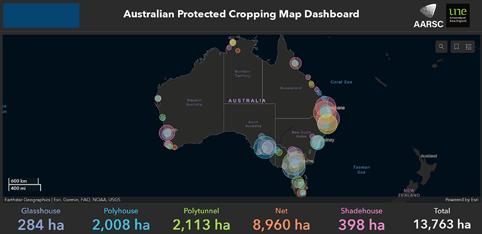
49
INDUSTRY
Figure 1. Australian Protected Cropping Map Dashboard. Source: www.arcg.is/1ebimm0
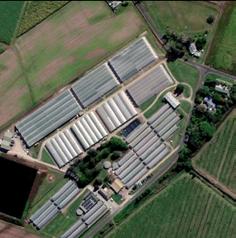
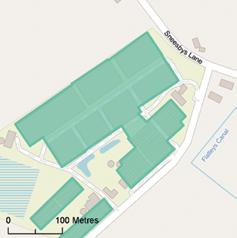
50 BERRY AUSTRALIAN JOURNAL AUTUMN 2023 EDITION 14
State / Territory Glasshouses Polyhouses Polytunnels Nets Shadehouses Total Queensland 4 311 352 1,916 98 2,681 New South Wales 58 382 603 2,908 117 4,068 Victoria 123 154 355 1,922 25 2,579 Tasmania 9 5 508 803 0 1,326 South Australia 81 1,109 24 798 27 2,039 Western Australia 9 47 268 534 116 975 Northern Territory 0 0 1 78 12 92 ACT 0 0 0 1 3 4 Total 284 2,008 2,113 8,960 398 13,763
Table 1. Total area of PCS Structures by state/territory (hectares)
Figure 2. Example of a polyhouse in satellite imagery and its mapped form. Source: Imagery © Maxar, Map data © OpenStreetMap contributors (Esri Basemaps)
Analysis of the map by Local Government Area (LGA) shows the largest concentration of greenhouses is in Playford (SA) with 790 ha (776 ha are polyhouses), whilst the Southern Downs (Qld) has the largest area of nets with some 1,134 ha followed by Coffs Harbour with 1,097 ha.
The spatial layer developed for this project is designed with direct industry engagement (Protected Cropping Australia and NSW Local Land Services), to ensure it is well validated and delivers the necessary information in a format that is practical, accessible and adheres to appropriate privacy requirements.


Information sources used to develop the map include remotely sensed data (imagery), state and national spatial information, field observations and expert knowledge. No personal or confidential information is collected as part of the mapping process nor contained within the map. The map simply presents a polygon feature that denotes the system type, no property information (e.g. block, variety, yield) and no personal information (grower, enterprise, owner) is included. The map is built to the national standards of the Australian Collaborative Land Use and Management Program, coordinated by ABARES.
Help us, help you
Stakeholders and growers are encouraged to contribute by viewing the draft mapping and adding their feedback. This engagement is extremely valuable and is essential for mapping new systems (which are not visible in satellite imagery due to the currency (date) of image acquisition).
The success of the mapping showcases the value of science and innovation across the horticulture industry in Australia. The maps built spatially enable Australia’s horticulture industry and support data-driven decision making.
The project team aim to finalise the national baseline map of PCS in June 2023, with further research and development of methods using machine learning for the automatic detection of new PCS, as well as webbased applications to support industry in maintaining the map in future.

The AARSC team have included a ‘National Map of Protected Cropping Structures’ section within our Industry Applications Gallery—www.une.edu.au/webapps.
You can help build the national map of Australia’s protected cropping systems by completing this 60 second survey in just four simple steps! Launch the survey by clicking this link (https://arcg.is/0H0L9P) or scan the QR code (it will open on any device).

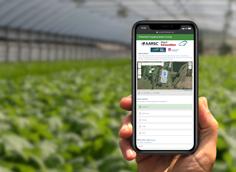
1. Add location of the protected crop by clicking on the map: either select the cross-hair button to quickly 'find my location' or search for an address
2. Place the pin on the protected crop by clicking the map and continue the survey (from a mobile device confirm the location by selecting either the or the back arrow (<) button in the top-left corner to continue the survey).
3. Select system type and optionally include the crop and a photo.
4. Click submit to complete the survey!
For more information please contact:

Craig Shephard | cshepha2@une.edu.au
Andy Clark | andrew.clark@une.edu.au

Acknowledgement
This project is being funded by Hort Innovation through the Hort Frontiers Advanced Production Systems Fund with co-investment from Future Food Systems CRC, Protected Cropping Australia LTD and Greater Sydney and North Coast Local Land Services and matched funding from the Commonwealth Government. AARSC is fortunate for the support of the project partners in this initiative.

51
Fruit volume down in the wake of increased prices and supply issues
Nielsen IQ
The multi-industry Hort Innovation project Consumer behavioural data program (MT21004) delivers the Harvest to Home dashboard (www.harvesttohome.net.au) and provides periodic insights into trends in fresh produce sales.
(-4.6%) versus last year, resulting in losses in volume share of trade (16.7% in 2022, down from 17.1% in 2021), as well as in dollar terms (13.7% in 2022, down from 14.2% in 2021).
According to statements made by the Treasurer in October 2022, rising fruit and vegetable prices are expected to continue increasing over the December 2022 and March 2023 quarters, and food prices, in general, will be responsible for the inflation peak expected over the next few months.
A review of annual sales performance for total fruit over 2022 (MAT* to 01/01/2023) reveals that while dollar sales held steady for the year (-0.9%), volume sales declined by -5.0%.
Volume sales for melons (-26.5%), berries (-14.5%), stone fruit (-13.1%), avocados (-12.0%) and mangoes (-5.7%) were down considerably, largely driven by another wet La Nina year resulting in rain-damaged crops and strained supply. Except for mangoes, all of these categories were subject to higher retail prices than the previous year.
Over the past two years, Australians have significantly cut back on their fruit spending and consumption. The average household spent $463.60 on fruit in 2022 (down from $489.80 in 2020), while the average volume per household dropped to 90.4 kilograms from 96.7 kilograms two years ago.
At a retailer level, sales trends for major supermarkets - which represent three-quarters of all fruit salesmirrored the national benchmark. Greengrocers/ Markets, the second biggest channel, recorded the strongest declines in volume (-7.3%) and dollar sales
Top 10 Performance Summary Berries
Of all the fruit categories, berries were the most susceptible to unpredictable weather, with periods of heavy rain resulting in waterlogged and bruised fruit. Berries recorded significant volume sales losses (-14.5%), with supply issues driving the average price per kilogram up to $17.60 (versus $15.30 in 2021). Despite the fall in the number of households purchasing and a decline in purchase frequency and volume purchased, the steep price rise offset overall annual dollar sales declines (-1.7%).
Bananas
The largest fruit category in consumption terms, bananas represented almost a quarter (22.6%) of all fruit volume sold. The average annual volume purchased of bananas per household remained stable versus last year; but lower prices resulted in decreased spending, which translated to a decline in overall dollar sales of -4.2%. Bananas recorded a moderate sales increase in volume versus 2021 (+1.2%).
52 INDUSTRY BERRY AUSTRALIAN JOURNAL AUTUMN 2023 EDITION 14
Falling rain, rising inflation levels, increased fuel, electricity and fertiliser expenses, and ongoing supply challenges have negatively affected fruit consumption in Australia over the past 12 months.
Apples
In both dollar (+0.3%) and volume (+0.3%) terms, total apple sales remained relatively unchanged in 2022 versus the previous year. All key consumer buyer metrics also remained stable, apart from a slight drop in the number of households (down to 86.8% versus 87.2% in 2021).
Citrus

The citrus fruit category was one of the only fruit categories within the top 10 to post both dollar (+3.0%) and volume (+3.3%) sales growth. The price per kilogram of citrus remained stable in 2022 versus the previous year, resulting in an increase in the average dollar spend per household and the amount of volume purchased.
Grapes
Within the top 10 fruit categories, grapes posted the strongest positive performance in dollar (+17.1%) and volume (+8.2%) sales over the past 12 months. Grapes also gained 1.3 percentage points to represent 8.2% of total fruit dollar sales. Despite higher prices ($9.30 per kilogram in 2022, up from $8.80 in 2021), volume per buyer still increased, while the average annual spend per buyer increased by $6.50 to $49.50.
Avocados
Following a couple of years of abundant supply and remarkably low prices, sales of avocados have had to adjust in 2022 to more realistic market pricing. Volume sales declined by - 12% in the past 12 months, driven by a fall in the number of households (now at 75.9% in 2022, stabilising from a record-high of 77.3% in 2021 versus 71.2% in 2020). Dollar sales also declined (-6.1%), although this was far less dramatic than what was recorded in 2021 (-20.4%). The average annual spend per household was $42.80 in 2022, down from $57.80 two years ago.
Stone Fruit
Like berries, stone fruit was also subject to weatherinduced supply issues, affecting availability during its usual peak summer season. The result was a decline in volume (-13.1%) and value sales (-8.1%), driven by a significant decrease in the number of stonefruit buyers. In the past year, 73% of households purchased stonefruit, down from 77.1% in 2021.
Melons
Melons were also negatively impacted by unfavourable growing conditions in 2022. Within the top 10 fruit categories, melons recorded the strongest volume declines (-26.5%). Supply challenges have resulted in a significant drop in the number of melon-buying households (59.2% in 2022 versus 66% two years ago), while the annual amount purchased has fallen to an average of 10.5 kilograms, down from 13.4 kilograms in 2021. Overall dollar sales for melons declined by -2.2%, with increased prices cushioning most of the impact.
Mangoes
Mango sales declined in both dollar (-8.4%) and volume terms (-5.7%) versus the previous year. While the number of households who purchased mangoes has held steady over the past two years (58.5%), purchase frequency, the average dollar amount spent and the amount of volume purchased all declined over the past 12 months.
Pears
Volume sales for pears decreased slightly (-1.0%) versus 2021, while dollar sales showed modest growth (+2.9%). All key household buying metrics for pears have remained relatively stable over the past year.
53
*MAT: Moving Annual Total
”Our customers have to deal with all kinds of challenges, so they need to know they can rely on a stable substrate. At Legro, we therefore invest in tomorrow’s raw materials. We are always looking for alternative ingredients that meet both the customer’s needs and our high quality requirements. Curious about what we can do for you? Contact me or one of my colleagues. Together we will find your blend for life.”
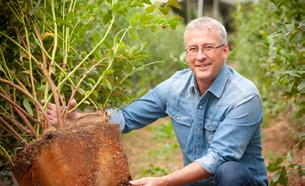
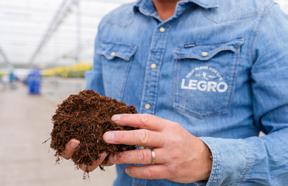


54 BERRY AUSTRALIAN JOURNAL AUTUMN 2023 EDITION 14 Innovation. Quality. Solutions. ®Fruition & Nova are registered trademarks of AgNova Technologies Pty Ltd ®Natflav is a registered trademark of Food Industry Products Pty Ltd. 220722 PESTEXPANDED RANGE
Unique action to attract mature egg-laying females
Easy to use technology
Include in IPM programs with Fruition Natflav® 500
•
•
•
Trap
flies www.legrogroup.com
loves the ladies The Revolutionary Lure &
for pest fruit
Phil Badgery Sales Manager Australia & New Zealand +61 (0) 3 95555267 info.aus@legrogroup.com your blend for life
Energy Efficiency for Recovery and Resilience Case Studies
 John Hay, Industry Recovery & Resilience Officer, Berries Australia
John Hay, Industry Recovery & Resilience Officer, Berries Australia
• Farms that reduce resource use through efficiency can reduce costs and increase profit
• By improving the triple bottom line, additional profit can be used to recover from adverse events, be reinvested in people and on projects that improve practices to drive diversity and resilience, ultimately leading to greater sustainability outcomes
The Energy Savers Plus Program, delivered by the Queensland Farmers Federation (QFF) with support and funding from the Queensland Department of Energy and Public Works was one initiative addressing these challenges and improving profits by conducting energy audits. Audits work by collecting baseline information about energy consumption and costs, investigating the current systems onsite, recommending efficiency improvements then calculating potential savings.
Berries Australia will continue this work by undertaking energy audits on Blueberry farms in the Coffs Harbour region and developing resources to help build capacity for berry growers. This capability comes after receiving grant funding from NSW Local Land Services under the Early Needs Recovery funding.
55
A solar installation can generate significant energy use savings. Photo credit: Pixabay
The reported energy consumption (427,300kWh) is spread between a packing shed, workshop and office areas, an air compressor, three large and two small cold rooms. The site had prezviously installed two small 5kW solar powered irrigation pumps and a 100kW solar PV system on the shed.
Consumption at the packing shed is split over two peak packing periods, February to April, and June to August. Due to the seasonality of production, there are six months of low consumption and with electrical network restrictions in place there is a cap on exports to the grid, reducing potential income.
It is important to consider that as regulations on the network begin to change additional export to the grid may be allowed.
Based on the current consumption, the audit highlighted a no cost quick win by changing from Tariff 62 to 50 (Large Demand) resulting in a saving of $12,094 per year. Additional savings of $1,919 per year could be achieved by changing another meter from Tariff 65 to Tariff 20.
To help manage consumption the audit recommended installing smart metering at the packing shed switchboard. At a cost of $11,000 with a potential saving of 8600kWh and $4,221 per year, this change would offer a payback period of just 2.6 years. In addition, a maintenance and monitoring program on the 100kW solar PV system
costing $5,000 could optimise performance saving 9,264kWh and $4,000 with a payback period of 1.3 years This package would enable monitoring of the current inverter communications system to flag errors and minimise system downtime. Without this, a reduction in solar output of 10% could be expected.
Further recommendations in the audit included:
• No cost: Air compressor pressure reduction from 10 bar to 9 bar to control air leaks saving 400kWh and $17 per year
• Low Cost: Installation of strip curtains costing $6,000 to reduce air losses and infiltration through the doorway saving 6000kWh, equating to $2596 with a quick payback of 2.3 years.
This site installed a Variable Speed Drive (VSD) on the cold room fan motors. VSDs work by reducing the motor speed and adding variability depending on the different load requirements at the time. By installing only the VSD, energy consumption has been reduced by 2% (17,951kWh) to 416,852kWh per year. Costs have been reduced by $3,448 with carbon emission savings of 8.5 t/CO2 e per year. Due to the seasonal fluctuations when conducting measurement and verification on the installation, the fans ran for only 53% of the available time suggesting there are even more savings on the way for this farm.
Site 2
Current Consumption (kWh)
310K
Current Cost ($)
95K
190.20K
Consumption Post Audit (kWh)
38.65 Energy Saving (%) 27.36 Cost Saving (%)
56 INDUSTRY BERRY AUSTRALIAN JOURNAL AUTUMN 2023 EDITION 14 Site 1 Current Consumption (kWh) 427K Current Cost ($) 385.09K Consumption Post Audit (kWh) 9.88 Energy Saving (%) 24.19 Cost Saving (%) 128K
The second site harvests 1200 tons of strawberries over 30 hectares. The farm has two main pump houses, one with three 55kW pumps and the other with three 37kW pumps in series, all of which are centrifugal split out over two areas.
Water is supplied from a dam through a mix of solid set sprinklers and T-tape drippers, and this irrigation system operates for 9 months of the year. The pumps were recently installed and in good condition and thus were not the focus of the audit.
Additional infrastructure onsite includes a large packing shed with sorting equipment and cold rooms, air-conditioned worker accommodation with lighting and a kitchen, four large cold rooms with separate condensers which are roughly 20 years old.
On average, energy consumption is 310,000kWh per year at a cost of $95,000. The baseline consumption metric of 260kWh/T of strawberries is expected to drop by 40% to 158kWh/T from installation of the recommendations shown in Table 1.
One final recommendation was to replace cassette air conditioners in the workshop with a single Variable Refrigerant Flow (VRF) unit with multiple heads. These are approximately 25% more efficient than current split systems.
This site is yet to install all the recommendations although potential energy savings of 39%, cost savings of $26,000, and emission reductions of 97t could be achieved per year.
Support for NSW Blueberry growers in the Coffs Harbour region is funded by the Early Needs Recovery Program (ENRP) which seeks to support industry organisations impacted by the February 2022 flooding event in NSW. The program provides an opportunity for each impacted industry to determine and facilitate tailored projects and activities to ensure the unique recovery needs of their primary producers are met.
For more information please contact: John Hay Industry Recovery and Resilience Officer 0488 147 800 | recovery@berries.net.au
57 Item Cost $ Saving kWh Payback years 30kW Solar PV on the packing shed $45,000 40,000 7.1 20kW ground mount on the smaller pump shed $34,000 17,300 9.9 30kW ground mount on the large pump shed $51,000 35,000 4.8 Replacing existing condensing units
on the
$80,000 27,500 14
with 4 new Variable Speed Drives (VSD)
compressor and the condenser fan
Table 1. Audit recommendations
Hort Innovation Churchill Fellowship Applications Open 1 March 2023
Hort Innovation is partnering with the Churchill Trust to develop tomorrow’s leaders of the Australian horticulture industry.
Up to three Hort Innovation Churchill Fellowships are available nationally this year for topics related to horticulture. To meet the criteria, applicants must be proposing to explore topics that provide clear benefit to the Australian horticulture sector and, ultimately, to the wider community; and be transformational in nature for the horticulture industry in general.
For projects that are specific to a particular horticultural industry, the applicant must be from a registered levypaying Australian horticulture business in that industry.
If your business isn't listed, the Churchill Trust still encourages you to apply for a general Churchill Fellowship.
The Hort Innovation Churchill Fellowships are jointly funded with the Winston Churchill Memorial Trust using Hort Innovation’s Leadership Fund, as part of a strategic co-investment initiative.

Previous recipients include:
• Food scientist and entrepreneur Belinda Hazell (2018) who travelled to New Zealand, the United Kingdom, Ireland and the Netherlands to investigate the use of horticultural quality assurance standards to stay ahead of social license demands.
• Queensland frozen berry producer Stuart McGruddy (2020) who is using his Fellowship to travel to the USA, France, Chile and Serbia to explore the knowledge, experience and technology used in freezing whole soft berry fruits,
• Tasmanian beekeeper Anita Long (2020) who is investigating development programs for young beekeepers that are scalable to an Australian context.
About Churchill Fellowships
The Winston Churchill Trust was set up in 1965 after the death of famous British prime minister and war-time leader Sir Winston Churchill, when the Australian public gave generously in what was one of the country’s largest ever door-knock appeals. The Churchill Memorial Sunday doorknock raised funds for an unusual type of memorial to Sir Winston. Endorsed by Churchill before he died, it was the establishment of a special Fellowship bearing his name to provide a unique opportunity for ordinary people to travel, learn and bring knowledge back to their country.
Since then, the Winston Churchill Trust has sent more than 4,600 Australians overseas to pursue their passion and bring back what they learnt to share with others. The contribution these Fellows have made to the country and the lives of Australians is immeasurable. Along the way, many of them have developed careers and international reputations that shine a light on their chosen field of endeavour.
The application round opens on 1 March 2023, closing 1 May 2023. Recipients will be announced in September 2023.
For more information visit www.churchilltrust.com.au/sponsor/?id=SP000302
58 INDUSTRY BERRY AUSTRALIAN JOURNAL AUTUMN 2023 EDITION 14
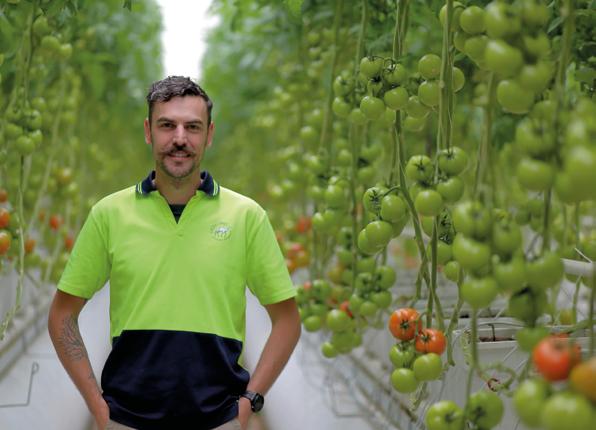


“Studying at WSU allowed me to
and
the theoretical knowledge of crop cultivation
everyday practical applications in my Glasshouse” Andrew
General
Operations Green Camel To find o ut mo re abo ut o ur p rotected crop p ing course s, give u s a c all on 130 0 897669, v i s i t o u r w e b p a g e o r c o n t a c t Prof Z h o n g h u a C h e n o n 0 4 6 6 5 4 4 6 9 6 z c h e n @ we s t e r n s yd n ey e d u a u C R I C O S p r o v i d e r c o d e 0 0 9 1 7 K SCHOOL OF SCIENCE
understand, interpret
apply
into
McIlwain
Manager
Strawberry levy update
Rachel Mackenzie, Berries Australia
Many of you would have heard rumours or been directly engaged in conversations about some issues with the strawberry levy fund. To cut a long story short, the royalty income held on behalf of industry by Hort Innovation was inadvertently included in the levy fund closing balance which made it appear that more funds were available. This meant that there was an insufficient amount in the levy fund to cover the industry’s three main priorities; the breeding program, the industry development and communications project and technical work in the export space to open new markets.
projects are set up in such a way as to deliver maximum industry benefit, not just benefit one growing region or type. Berries Australia will also be working through the communications and IDO project to ensure that as much benefit can flow to individual levy payers as possible.
The detailed scrutiny of the levy fund has also shown that in real terms levy income is decreasing. There are a range of factors contributing to this scenario including new varietals producing more fruit from fewer runners. There is a certain irony that the levy-funded breeding program is directly contributing to the reduction of the levy, but ultimately improved runner efficiency is a good thing.
The negotiation process certainly highlighted the range of views across the industry as to the priorities and I was very impressed with how each of the SAI Directors were able to balance the needs of their region whilst still considering what was good for the industry overall. The process demonstrates how much SAI has matured in the last few years and the industry as a whole is able to negotiate its way through tricky situations without everyone falling back into their state-by-state viewpoints. This situation has also highlighted the need for all projects to ensure that the benefits are distributed equally across Australia. Strawberries Australia will be taking a much more active role in ensuring that all
Whilst the committee is a very long way from making any decisions about levy amounts or collection methods it is worth putting this issue on your radar. No decisions would be made without extensive consultation and any possible changes could only proceed if the majority of industry was supportive. The committee understands that the last few years have been challenging from a profitability perspective so the appetite for increasing costs would be low. In the meantime, the focus must remain on ensuring all levy payers get the maximum benefit from their investment.
We are pleased to welcome the new Hort Innovation Industry Service & Delivery Manager for Berries Adrian Englefield. I am sure with Adrian’s help we can drive value back to the levy payer and ensure funds are appropriately spent on high value projects.
60 STRAWBERRIES BERRY AUSTRALIAN JOURNAL AUTUMN 2023 EDITION 14
It is important that we all recognise that everyone makes mistakes, and we need to accept people’s efforts to resolve the issue satisfactorily. Hort Innovation has made significant efforts to work with Strawberries Australia (SAI) to negotiate a suitable outcome, and I am pleased to say that with the utilisation of forward royalty income, all three priority projects will proceed.
Strawberry growers to receive targeted climate information
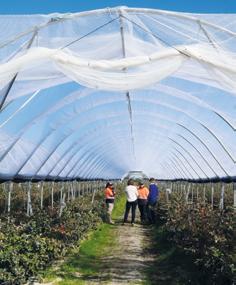 Helen Newman, Berry Industry Development Officer, Agricultural Produce Commission (WA)
Helen Newman, Berry Industry Development Officer, Agricultural Produce Commission (WA)
Climate Services for Agriculture (CSA) is a national project involving the Bureau of Meteorology, CSIRO and FarmLink Research, designed to help growers recognise trends and conditions that may impact the way they operate on farm.
The CSA platform allows growers to search weather and climate indices by location and commodity, to assist them with on-farm decision making, and planning for climate-related impacts to their enterprise.
You can see a prototype of the tool by visiting climateservicesforag.indraweb.io
While climate information for all major agricultural and horticultural commodities will ultimately be made available, strawberries are the first berry to be included. The CSA development team plan to add strawberries early in 2023. The information will include 60 years of historical climate data, as well as future forecasts for a medium-to-long-term time horizon.
The addition of strawberries to the platform will allow growers to access climate data specific to a strawberry-growing enterprise. This information might include, for example, trends in day/night temperatures and light during flower bud initiation and fruit development, winter chill, evapotranspiration, rainfall distribution, and frost incidence.
To do this, the CSA team needs to speak directly to strawberry growers and agronomists, to understand the industry’s climate and weather challenges and how they manage them. These discussions take 45-60 minutes via video call, at a time and date nominated by the grower.
If you are a strawberry grower, the CSA team wants to hear from you. To participate, or find out more, contact Sarah Clarry on 0419 165 771 or email comms@farmlink.com.au
Growers of other berries are also welcome to get in touch, as more berries will be added to the platform throughout the year. The information that growers provide will inform the development of the platform and ensure the right climate information is available.
The CSA engagement team meeting with Costa Group’s Anurdha KaravitaArachchi and Olivia Bell, and WA Berry Industry Development Officer Helen Newman to discuss climate-related issues for blueberry production. Indices presented on the platform for the various commodities are the result of extensive industry consultation. Photo credit: Sarah Clarry
STRAWBERRIES
61
Example data sets from the platform
The Climate Services for Agriculture platform delivers commodity and location-specific climate data for growers. Growers can view historical data sets relevant to their location and or crop. Figure 1 is a crop-specific example, showing 60 years of data for chill portions for Albany, WA based on the chill requirements of an almond crop. Figure 2 is a general location example and shows 60 years of annual rainfall data for Wanneroo, WA.

The Climate Services for Agriculture platform also allows growers to explore how climate change will impact a particular location and or crop. Figure 3 shows historical and projected annual rainfall for Wanneroo, WA and Table 1 shows historical and projected heat risk for the same area. Table 2 is a crop-specific example showing historical and projected extreme years (high temperatures ≥ 37°C from fruit set to fruit drop) for a citrus crop in Wanneroo, WA.

62 BERRY AUSTRALIAN JOURNAL AUTUMN 2023 EDITION 14
Figure 1. Chill portions (Mar-Jul) for Albany, WA for an almond crop (1961-2020).
Past temperature data is sourced from the Bureau of Meteorology's Australian Gridded Climate Data (AGCD) dataset.
Figure 2. Annual rainfall data for Wanneroo, WA (1961-2020).
Past rainfall data is sourced from the Bureau of Meteorology's Australian Gridded Climate Data (AGCD) dataset.
Table 1. Extreme years - historical and projected annual heat risk for Wanneroo, WA.
This table shows how many years (out of 10) have fallen or are projected to fall below or above 35°C under a medium greenhouse gas emissions scenario.

Year range
1961-1990
1991-2020
Number of years with annual heat risk below 13 (days Tmax ≥ 35°C)
Number of years with annual heat risk above 25.4 (days Tmax ≥ 35°C)
Table 2. Extreme years - historical and projected high temperatures from citrus fruit set to fruit drop (mid-October to late December) for Wanneroo, WA.
This table shows how many years (out of 10) have fallen or are projected to fall below or above 37°C under a medium greenhouse gas emissions scenario during the mid-October to late December period.

Year range
Number of years with high temperatures at fruit set to fruit drop below 0 (days Tmax ≥ 37°C)
1961-1990 0 in 10 years
1991-2020 0 in 10 years
2016-2045 0 in 10 years
2036-2065 0 in 10 years
2056-2085 0 in 10 years
Number of years with high temperatures at fruit set to fruit drop above 4 (days Tmax ≥ 37°C)
0.3 in 10 years
0.7 in 10 years
2 in 10 years
2.8 in 10 years
3.3 in 10 years
Acknowledgements: Climate Services for Agriculture is funded by the Department of Agriculture, Fisheries and Forestry, through the Future Drought Fund. For more information, visit: https://www.agriculture.gov.au/agriculture-land/farm-food-drought/drought/future-drought-fund/climate-services
Figure 3. Historical and projected annual rainfall for Wanneroo, WA).
1.3
in 10 years 2 in 10 years
0.3
10 years
10 years
0.1
10
4.4
0
10
6.3
0
10
in
1 in
2016-2045
in
years
in 10 years 2036-2065
in
years
in 10 years 2056-2085
in
years 7.8 in 10 years
63
Drive your profit curve up. Point your input costs down.
The missing ingredient for plant health and growth.

We are pleased to introduce MaxSil, a world class silicon plant and soil nutrient. Patented in many countries, MaxSil is a potent solution for improving plant growth and yield.
MaxSil reduces the need for NPK inputs and increases Nutrient Uptake Efficiency, allowing plants treated with MaxSil to extract more nutrients from the soil matrix than untreated plants.
A silicon products’ efficacy should always be measured by the amount of “soluble” or “Plant Available Silicon” (“PAS”) it contains using the globally accepted test for soluble silicon (the “5 Day Method”). MaxSil contains in excess of 20,000 ppm which is up to 20 times higher than other solid silicon products offered by our competitors. This translates to lower dose rates and lower costs per hectare to deliver an equivalent amount of PAS.
You can expect to see increased root mass and stronger plants with higher yields as well as increased resistance to biotic and abiotic stress.
MaxSil is manufactured from recycled materials making it a part of the “Circular Economy”. Good for your profits, good for your crops, good for the environment. We invite you to try our product and experience the benefits for yourself.
MaxSil™ contains in excess of 20,000 ppm PAS - 20 times higher than nearest competitor
Scan
www.maxsil.com.au 0 PAS CONTENT Kg/t 2 4 6 8 10 12 14 16 18 20 Kg/t CALC SILICATE DIATOMITE MAXSIL TM
me
Queensland Strawberry farmer wins Australian Organic Farmer of the Year
Jane Richter, Communication Manager, Berries Australia
Growing consistently high-quality fresh produce in today’s challenging climate is definitely part science and part art. When you add the complication of growing to a certified organic standard, you have to think very creatively about ways to tackle some of the production challenges you face.
Brendon Hoyle from Ashbern Farms, a dual location strawberry business in southern Queensland, was recently named as Australian Organic Farmer of the Year, partly for his unusual method of managing the sucking insect Rutherglen bug in the 4.2-hectare organic part of their strawberry business at the Glass House Mountains.
In a radical innovation, Brendon uses an industrialsized vacuum machine mounted on a tractor to literally ‘suck up’ the Rutherglen bug and other pests from the strawberry rows. This innovation allows the farm to continue organic production without the use of pesticides into a time window when traditionally these pest numbers explode due to the warming temperatures of spring.
The bug vacuum is only used for a few weeks at the end of the Sunshine Coast winter strawberry growing season, carefully timed to avoid periods of the day where beneficial insects like honey bees are most active. If the Rutherglen bug is bad, they run over the crop every couple of days. The first pass generally picks up a fair amount of leaf litter, so the screens need to be decluttered a few times.
“The morning time is generally not that good for the Rutherglen bug activity, so we try to leave it to later in the day when the bees have stopped but there is still some warmth left in the day. The Rutherglen bugs sit on the fruit until late afternoon, whereas they seem to
move well under the canopy or even under the plastic in the evening,” explains Brendon.
Each season is different for pest pressure, but in the 2022 season this innovative way of tackling Rutherglen bug enabled the organic production to continue all the way to the effective end of the season in mid-October, giving the farm four additional weeks of viable highquality production. The bug-sucker will also kill any other insects that are in the crop like Queensland Fruit Fly.
Brendon first saw a similar piece of equipment in use on a strawberry farm in California back in 2015, and with the help of some blueprints sourced from the internet one very handy team member fabricated a single row prototype to do a proof-of-concept, which is always a good idea when you are innovating. It worked and so a larger three-bed machine was made which operates via the Power Take-Off (PTO) at the back of a 50HP tractor. It also has an external hydraulic motor as it needs a lot of oil flow, and apparently it sounds like a Boeing taking off so good ear-protection is a must!
The farm also uses a significant number of beneficial insects, and to keep across the pest life cycles and populations almost daily crop scouting is needed. This means that the farm has developed significant in-house expertise to manage the day-to-day implementation of their program, supplemented by expert advice from a local agronomist and the IPM insect suppliers.
STRAWBERRIES
65


66 BERRY AUSTRALIAN JOURNAL AUTUMN 2023 EDITION 14
Australian Organic Farmer of the Year, Brendon Hoyle from Ashbern Farms in Queensland accepting his award from Nick Koch, Corteva Agriscience, ‘Farmer of the Year’ Award Sponsor.
Photo credit: Australian Organic Limited
The bug vacuum unit can cover three rows in a single pass.
Photo credit: Jane Richter
“You have to have an intimate knowledge about the pests – what’s going on in the crop, what’s going on in the weather – to try and help predict what’s coming your way. This last year we used up to eight different beneficials. We had a lot of aphid activity which was a significant issue and did wasp releases several times across the season.”
It all comes down to experience and timing – timing is everything.
Experience built up over the last few years has enabled the farm to be able to start anticipating likely pest issues before they occur, meaning they can take preemptive action and gain control over the population numbers more quickly.
“With Rutherglen bug, we’ve had some big infestations come in on the westerlies. You can pick up within hours when they’ve arrived, and if you can get on top of it right then and there, then it’s only a matter of days before you can have it under control. If you don’t know what you’re looking for then the population just booms and it’s too late.”
“In some ways we’re fortunate in our organic production as we’re not able to use traditional chemical solutions, we’ve got to find other alternatives which forces us to be creative. And we can take those learnings over into our traditional production to reduce overall chemical use, and therefore input costs. There are a lot of techniques now that we honed in the organic section that we use over in our conventional production. In our conventional farm side, we’re trying to get out of that mindset of spraying for fear – the ‘what happens if I don’t spray this’ mentality.”
“The focus in our organic production is to grow the best that we can and not the most that we can; we don’t want to be the biggest, we just want to grow the best.”
“We involve our team to help solve issues, drawing on their farming experiences and giving them a chance to be directly involved with a vested interest in the business.”
“The Australian Organic Farmer of the Year award is such a privilege, and an achievement our team is proud to share for all the hard work, not only in growing but picking and packing, and tackling the challenges along the way,” Brendon said.
The Organic Market in Australia
Australia remains the world’s largest holder of agricultural land under certified organic management with over 23 million hectares of Aussie soil now organic. It’s a number that reflects the rise in consumer preferences for organic and natural products that we’ve seen in recent years and that COVID-19 boosted in 2020. The Australian organic food industry is continuing to boom. In 2021, the retail value of the organic market was estimated to be at least $2.3 billion. Australia has seen a compound annual growth rate of 13% since 2012, with the number of certified organic operations increasing by 38% since 2011.
Consumer demand for organic food is growing at a rate of 20 to 30% per year. According to the 2021 Australian Organic Market Report, 80% of Australian food shoppers are receptive to purchasing organic food, with 63% of shoppers believing that “chemical free” is the primary perceived benefit of organic products and 9 million households purchasing at least one organic product in 2020.
About Australian Organic Limited (AOL)
Australian Organic Limited (AOL) is the peak industry body engaging with government and industry to promote the commercial and social interests of those who are certified and protect the integrity of the certified industry against fraud and misleading organics. AOL has been at the foundation of organics since 1987 and is identified by the most recognised mark in Australia, the Australian Certified Organic Bud trademark.
Organic food production is based on a system of natural farming that maintains and replenishes soil fertility without the use of pesticides or synthetic fertilisers and prohibits genetically modified organisms (GMOs). Once you have decided to convert to organic production, the next step is to choose an organic certification body. From the start of your certification application, it can take between 1-3 years to become certified organic for producers, dependent on previous farm chemical usage and history.
67
Acknowledgements
Part of this article has been reproduced with thanks from the interview with Jennifer Nichols published at ABC Rural https://www.abc.net.au/news/ rural/2022-12-04/bug-vacuum-strawberries-queensland-fruit-fly-australian-organic/101706370 and further information has been reproduced with thanks to Australian Organic Limited https://austorganic.com/brendon-hoyle-named-farmer-of-the-year-at-2022-australian-organic-industry-awards



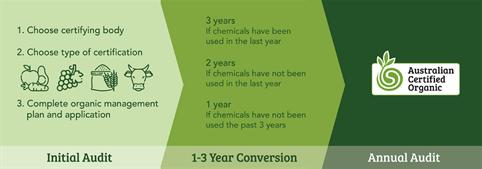
68 BERRY AUSTRALIAN JOURNAL AUTUMN 2023 EDITION 14 HOW TO GET CERTIFIED Find out more at www.austorganic.com Did you know that you can combine your organic and food safety certification audits to save time and money? These Certification Bodies are approved to provide audits to the Freshcare Standards and organic standards, and may be able to provide a combined service for both audits. Contact the Certification Body direct to discuss your options
07 3350 5706 info@aco.net.au www.aco.net.au 1800 630 890 fresh@ausqual.com.au www.ausqual.com.au 08 7231 7700 info@ncocertifiedorganic.com.au www. ncocertifiedorganic.com.au
Now registered for use on Strawberries
Coragen® insecticide is a robust larvicide with good residual activity and a favourable IPM profile. Coragen® will help you to control Cluster caterpillar (Spodoptera litura), Cotton bollworm (Helicoverpa armigera), and Native Budworm (Helicoverpa punctigera) in both field and protected cropping systems.
Can be used in conjunction with Benevia® and Avatar ® . Visit www.fmccrop.com.au for more information.

Recommended positioning in Strawberries (6-7 months)

Aphid complex
Thrips complex
Insect Control
FMC Australasia Pty Ltd Phone: 1800 066 355 www.fmccrop.com.au ALWAYS READ AND FOLLOW LABEL DIRECTIONS. Copyright © 2023. All rights reserved. FMC, Coragen®, Avatar® and Benevia® are registered trademarks of FMC Corporation or its affiliates. 01/23
Pests Transplant to vegetative First flower First flower to fruit set Fruit set to harvest End harvest
Heliothis Leaf miner
BENEVIA® AVATAR® CORAGEN® Use a maximum of four (4) Group 28’s per crop per season
1 insect generation. Group 28
spray period
free
Inconsistent quality under global warming dampens strawberry performance in SEQ
Christopher Menzel, Principal Horticulturist, Queensland Department of Agriculture and Fisheries
• Weather affects the yield and quality of strawberry plants
• Cultivars with stable fruit quality are preferred over those with variable quality
• Fruit quality data from six strawberry cultivars was collected to assess the stability of three key fruit quality traits (fruit weight, sweetness, and acidity) over a season
• None of the cultivars tested had high and stable fruit quality values suggesting more needs to be done to develop better performing cultivars, particularly for production under global warming
Introduction
Environmental conditions affect the yield and quality of fruit produced by strawberry plants. Fruit weight, soluble solids content (a measure of sweetness), titratable acidity (a measure of fruit tartness) and firmness increase with increasing solar radiation. These same parameters, however, decrease with rising, warmer temperatures, leading to reduced marketable yield and softer, blander tasting fruit.
In many agricultural crops, stable yield and product quality is as important as a high average yield or high product quality. This is also true for strawberries, where cultivars with stable quality under variable environmental conditions are preferred over those with variable quality.
In this research, the stability of yield and fruit quality parameters of six strawberry cultivars was assessed at trials in Nambour, Queensland. Bare-rooted transplants from Toolangi in Victoria were planted on 20 April 2022, and mature fruit were harvested weekly from 3 August to 19 October. Data on marketable yield, fruit weight, soluble solids content (SSC), and titratable acidity (TA) was collected and assessed for stability each week.
How stability was assessed
In this trial, the stability of yield and quality parameters for each strawberry cultivar was assessed using a regression protocol described by Finlay and Wilkinson (1963).
Cultivars with a slope from the averaged regression line of one (1) have average stability within the group.
Cultivars with a slope of more than one (1) are less stable than average, while cultivars with a slope of less than one (1) are more stable than average.
Results of the trial
Marketable yield was similar across the cultivars, ranging from 352 to 416 g/plant. Fruit size was smaller in Festival and Grenada, intermediate in Fortuna and the Advanced Selection, and larger in Fronteras and Petaluma. Average SSC was lower in Fronteras, Grenada, and Petaluma than in the other cultivars, while average TA was lower in Fortuna and Fronteras (Table 1).
70 STRAWBERRIES BERRY AUSTRALIAN JOURNAL AUTUMN 2023 EDITION 14
All cultivars had similar estimates of stability for fruit weight (0.74 to 1.27), where a cultivar with a value of one (1) has average stability in a group. Estimates of stability for SSC and TA varied with the cultivar. Estimates of stability for SSC were lower than one for Festival and Fortuna (more stable than average), about one for the Advanced Selection and Petaluma (average stability), and higher than one for Fronteras and Grenada (less stable than average). Estimates of stability for TA were lower than one for Fortuna and Fronteras (more stable than average) and about one for the other cultivars (average stability) (Table 2).
There was a strong negative linear relationship between fruit weight and the temperature in the seven weeks before the fruit were harvested (P = 0.018, R2 = 0.39). Fruit weight decreased from 27 g to 22 g as the average daily mean temperature increased from 15.4º to 18.8ºC. There was also a strong negative linear relationship between SSC and temperature in the eight days before the fruit were harvested (P < 0.001, R2 = 0.87). Soluble solids content decreased from 8.1 to 6.7% as the temperature increased from 15.1º to 19.8ºC (Figure 1).
Table 1. Variations in marketable yield, and mean seasonal average fruit weight, SSC, and TA. Data are the means of six replicates per cultivar and were collected from 3 August to 19 October.
* Marketable fruits were at least 12 g fresh weight, were not affected by rain or grey mould, were not misshapen and had no other defects.
Table 2. Variations in the stability of fruit weight, fruit soluble solids content and fruit titratable acidity. Data are the means of six replicates per cultivar and were collected from 3 August to 19 October. Estimates of stability were calculated using the regression analysis used by Finlay and Wilkinson (1963).
Significantly more stable than average Average stability
Significantly less stable than average
Cultivar Marketable yield* (g/plant) Fruit weight Polytunnels Soluble solids content (%) Titratable acidity (%) Festival 379 21.3 8.3 0.66 Fortuna 363 25.0 7.5 0.58 Advanced Selection 352 24.7 7.4 0.67 Fronteras 416 27.6 7.1 0.55 Grenada 362 23.7 6.9 0.69 Petaluma 353 27.8 7.2 0.63
Cultivar Stability index Fruit weight (g) Soluble solids content (%) Titratable acidity (%) Festival 0.84 0.53 1.16 Fortuna 0.74 0.45 0.33 Advanced Selection 0.80 0.84 1.33 Fronteras 1.10 1.69 0.60 Grenada 1.19 1.75 1.29 Petaluma 1.27 0.88 1.11
71
Fruit quality varied with the cultivar and harvest and there were differences in the stability of fruit weight, SSC and TA. These differences in quality would affect the marketability of the various cultivars.
Hasing et al. (2013) studied the changes in SSC over the season in Florida. The typical harvest in this area extends from November to March and is characterised by a range in the weather. Hasing and colleagues found that SSC ranged from 5.1 to 9.9% in the first season and from 6.5 to 10.6% in the second. Approximately 90% of the genotypes had average stability, with the remaining 10% equally distributed between unstable and stable groups. There were a few genotypes with a high average SSC and stable values over the season.
The flavour of strawberry is a complex mixture of various attributes, including sweetness, acidity and aroma. Guan et al. (2022) indicated that First Grade fruit in the United States must have a SSC of at least 7%.
In the present study, the different cultivars varied in the number of occasions they failed to meet this standard. Festival and Fortuna passed on all harvests, Advanced Selection and Petaluma passed on eight or nine harvests, while the other two cultivars passed on six or seven harvests. The quality of the strawberries varied with the cultivar and the time of harvest in the trials. Festival and Grenada had smaller fruit than the other cultivars. Fronteras, Grenada and Petaluma had lower SSC and
Fortuna and Fronteras had lower TA. Both fruit weight and SCC decreased with increasing temperatures. None of the cultivars had high and stable values for all three fruit traits.
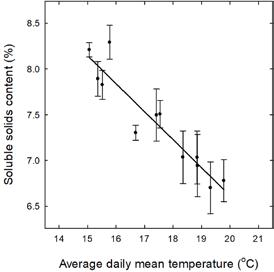
Inconsistent fruit quality dampens the performance of strawberries in southern Queensland. Efforts need to be made to develop cultivars with high average and stable quality values suitable for production under global warming. Research is also required to determine the stability of fruit quality in other growing areas.
Acknowledgements
The Queensland government is funding the research through the Department of Agriculture and Fisheries. Many thanks to the Florida Strawberry Growers’ Association (FSGA) for financial support and to Gary Hopewell for reading an earlier draft of the article.
References
Finlay, K.W., Wilkinson, G.N., 1963. The analysis of adaptation in a plant-breeding programme. Australian Journal of Agricultural Research 14, 742–754.
Guan, W., Haseman, D., Ingwell, L., Egel, D.S., 2022. Strawberry cultivar evaluation for fall-planted high tunnel system. HortTechnology 32, 542–551. Hasing, T.N., Osorio, L.F., Whitaker, V.M., 2013. Within-season stability of strawberry solids content. Journal of the American Society for Horticultural Science 138, 190–197.
72 BERRY AUSTRALIAN JOURNAL AUTUMN 2023 EDITION 14
Figure 1. Relationship between average fruit SSC and average daily mean temperature. Temperature data was averaged over the eight days before harvest. Data points are the averages of six cultivars (± standard error). SSC = Intercept – 0.31 × Temperature (P < 0.001, R2 = 0.87, n = 12).


73 Brinkman Australia Pty Ltd | 18-20 Jarrah Drive, Braeside | Victoria 3195 T 03 9587 2566 | info@royalbrinkman.com.au • Quality • Reliability • Performance • Custom blending Royal Brinkman Premium Coco Substrates by BioGrow royalbrinkman.com/australia bio-grow.com/en/biogrow
dinner& awards 2023


The 2023 Queensland Strawberry Industry Dinner and Awards Night will this year be held at the Pelican Waters Resort in Pelican Waters, Caloundra on Saturday 13 May 2023.


This event is a highlight on the strawberry calendar and is looked forward to by growers and industry associates alike, with over 150 attending each year.
It’s a great opportunity to catch up with friends and network with colleagues and customers pre-season, and we would love to have your support.
FOR TICKETS, MORE INFORMATION & SPONSORSHIP OPTIONS
Visit bit.ly/QSGA-Dinner-23
SATURDAY 13 MAY
Out and about in the Victorian strawberry industry
Helen Newman (WA) & Angela Atkinson (VIC), Berry Industry Development Officers (IDO)
The IDO team met in Melbourne in November 2022 for a project planning meeting. While we were there, we took the opportunity to visit the Victorian Strawberry Industry Certification Authority (VSICA), Toolangi runner and plug producers and local strawberry growers. A big thank you to Angela Atkinson for organising the itinerary. It was fantastic to see some of the advanced techniques being used out in the field and in the packing shed. Here is a summary of what we saw.
Victorian Strawberry Industry Certification Authority (VSICA), Toolangi, Victoria
VSICA is the not-for-profit organisation that provides certification services to the strawberry runner industry. It is based in the Toolangi Plant Protection District, surrounded by state forest, to minimise pest pressure. VSICA produces and maintains a disease-tested nucleus collection for a number of clients, including the Toolangi Certified Strawberry Runner Grower’s Co-op. VSICA also produce certified foundation plug plants in a high health screenhouse which are supplied to specialist mother stock runner producers.
Another important role of VSICA is the inspection and certification of runner crops and plug plants throughout the growing season produced by the Co-op to supply strawberry fruit growers.
In Figure 1, you can see recently planted nucleus daughter plants for Foundation stock production, taken on 17 November 2022. By mid-March 2023 these plants will have developed a thick curtain of foliage (a runner curtain as seen in Figure 2) ready for harvest and plug production. The red nozzles you can see in Figure 1 are part of an automatic (robotic) boom sprayer that is used to apply fungicides and fertigation. Mesh benches used to hold plug plants when they are harvested (as seen in Figure 3) are folded up in this photo to allow the runner curtain to grow down.
Perry Family Farms, Toolangi, Victoria
Perry Family Farms grow both strawberry plug plants and runners for the Toolangi Certified Strawberry Runner Grower’s Co-op, as well as being one of the propagators of mother stock plants for the Co-op.
Approximately 5% of their production is plug plants grown in tunnels, while the majority of production is bare-rooted runners in the ground. They have recently doubled their capacity for plug plant production, building a series of new tunnels. Plug plant production next year is expected to be just under 2 million units.
The majority of the plug plants produced are Red Rhapsody, but Albion and Cabrillo are also produced for the temperate regions (Figure 4).

STRAWBERRIES
75
Toolangi is located about 1.5 hours Toolangi Melbourne



76 BERRY AUSTRALIAN JOURNAL AUTUMN 2023 EDITION 14
Figure 2. Curtain of runners for plug production.
Photo credit: VSICA
Figure 3. Plug plants produced from the runner curtain.
Photo credit: VSICA
Figure 1. Recently planted nucleus daughter plants for Foundation stock production. Photo credit: Helen Newman
Sunny Ridge Farms have operations on the Mornington Peninsula, in the Yarra Valley, and in Queensland. We visited the Mornington Peninsula farm and spoke with Daniel Rolek, Sunny Ridge’s National General Manager. At this site, Sunny Ridge grow strawberries both in the field and on tabletops in tunnels; they also grow Rubus and blueberries at the site.

Sunny Ridge recently installed a laser bird scaring device on the farm. It appears to be working well but requires the occasional check-up to make sure it doesn’t go off target; this is particularly important near aviation flight paths.
Sunny Ridge has been using heat sealers on their packing line for the last five years. Around 80-90% of their production is packed in heat-sealed punnets.
Daniel estimates that the payback period on the machines was just 2 to 3 seasons. Heat-sealed punnets can contain up to 60% less plastic than standard lidded punnets and are more tamper-proof. While they were initially more expensive, now that more growers are using them they are comparable to the standard square tumble packs in price.
These machines can seal at 100-120 punnets per minute, and when quality is good, they can run at full speed, while if quality is down and packing is slower, they might run them at 60-80 punnets per minute. Daniel estimates that when quality is good and the units can run at maximum speed there is potentially a 15% saving on labour.
77
Figure 4. L-R: Aileen Reid (WA), Angela Atkinson (Vic), Helen Newman (WA), Shane Perry, (Perry Family Farms) and Mark Salter (Tas) in one of the high tunnels for plug plant production. Photo credit: Helen Newman
The IDO team would like to thank everyone that gave up their time and energy to show us around and share their knowledge and innovative practices; it was very much appreciated.
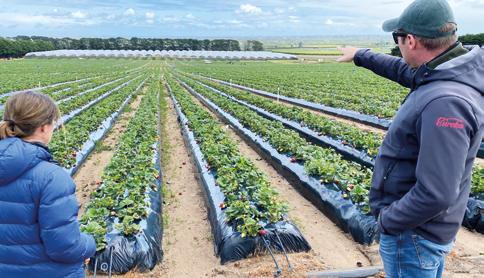


78 BERRY AUSTRALIAN JOURNAL AUTUMN 2023 EDITION 14
Figure 6. Heat seal machine in action on the packing line at Sunny Ridge.
Photo credit: Helen Newman
Figure 5. Daniel Rolek from Sunny Ridge (pictured with Melinda Simpson NSW IDO) explaining how their new laser bird scaring device works.
Photo credit: Helen Newman









08 8347 3838 TRICAL PARTNERS WITH YOU TO IMPROVE YOUR SOIL HEALTH trical.com.au StrikeFumigants.com FUMIGATION PARTNERSHIPS INNOVATION Promotes native beneficial soil micro-organisms. Supports growth of a healthy root system. Improves water and nutrient-use efficiency. Results in thriving plants with less crop stress. Increases marketable crop yields.
Vale Dennis Phillips
1950 — 2023
Many readers will remember Dennis for his dedication to the strawberry industry and advocacy for Western Australia throughout his 38 years in the Department of Agriculture. Dennis sadly passed away on 22 January 2023 after a period of illness.
Dennis was appointed to head the Department of Agriculture’s strawberry Research and Development Program in 1996. He hit the ground running, taking on the role of WA representative on the Strawberries Australia Technical Steering Committee in 1997 and acquiring funding for a full-time research officer to work on Strawberries in 1998. Dennis also represented WA on the national breeding steering committee and coordinated the local evaluation of varieties from breeding programs in Victoria and Queensland.
Dennis was instrumental in obtaining funding for a range of strawberry research projects in WA. These included projects on nutrition and irrigation management, root and crown disorders, pest management, cold chain management, shelf life, and sensory evaluation.
He also investigated the impact that planting time and the use of plug plants had on yield, and coordinated study tours for growers to the USA in 2005, and the UK, Spain, and Belgium in 2006.
In 2007, Dennis was awarded the ‘AUSVEG Researcher of the Year Award’ and in 2008 he received the ‘Department of Agriculture and Food Excellence Award for Horticultural Research’.
Dennis will be deeply missed by his former colleagues and extensive industry network, and remembered for his significant contribution to advancing strawberry research and development in Western Australia.

80 STRAWBERRIES BERRY AUSTRALIAN JOURNAL AUTUMN 2023 EDITION 14
Growing strawberries in Scotland
John Gray, Angus Soft Fruits
Recently we had the pleasure of hosting John Gray, Managing Director of Angus Soft Fruits (www.angussoftfruits.co.uk) located in Angus, Scotland, to give him a brief tour of the Australian berry industry. John was visiting berry businesses and other horticultural enterprises in Victoria, Tasmania and New Zealand as part of a Nuffield Farming Scholarship looking at how berry growers can increase their share of the value chain. We asked John if he could give us a snapshot of the Scottish Berry Industry, one that we don’t often hear about, and we will be looking forward to hearing the outcomes of his Nuffield research.
In Angus, on the east coast of Scotland we enjoy a mild micro-climate. The influence of the North Sea means that winter temperatures rarely go below freezing and in the summer day-time temperatures average just nineteen degrees Celsius, ideal growing conditions for berries! The introduction of tunnels in the mid-1990s and table tops in the early 2000s were game changers reducing the risk of crop loss from rain which we get all year and improving labour efficiencies.
Over the past twenty years, the Scottish berry industry has seen massive growth and now supplies approximately 20% of UK berries. The UK berry market has a year-round value in excess of £1.6 billion with berries now accounting for close to a quarter of all fruit sales in UK supermarkets. Our industry trade association - British Berry Growers - has been very active in raising consumer awareness for the health benefits of berries.
Angus Soft Fruits, established in 1994, is a family-owned business. We breed, grow, pack and market strawberries, raspberries, blackberries and blueberries to customers in the UK, Europe, the Middle East and Asia.
SCOTLAND ENGLAND WALES IRELAND NORTHERN IRELAND 81
STRAWBERRIES


 The East Seaton farm in Scotland – owned by John’s cousin who is also Chairman of Angus Soft Fruits- where strawberries are grown on table tops as part of a 150 hectare tunnel system. This is just one of multiple farms growing berries both in the UK and overseas in collaboration with Angus Soft Fruits enabling the business to offer year-round supply to its customers.
Photo credit: Liam Anderstrem, Airborne Lens Company
Strawberries growing on table tops at Angus Soft Fruits.
Photo credit: Angus Soft Fruits
John Gray. Photo credit: Angus Soft Fruits
The East Seaton farm in Scotland – owned by John’s cousin who is also Chairman of Angus Soft Fruits- where strawberries are grown on table tops as part of a 150 hectare tunnel system. This is just one of multiple farms growing berries both in the UK and overseas in collaboration with Angus Soft Fruits enabling the business to offer year-round supply to its customers.
Photo credit: Liam Anderstrem, Airborne Lens Company
Strawberries growing on table tops at Angus Soft Fruits.
Photo credit: Angus Soft Fruits
John Gray. Photo credit: Angus Soft Fruits
All our production is protected with polytunnels, with the majority of crops grown in table-tops and in substrate. Our natural seasonal peaks in late June and early July coincide with the peak of UK demand at the time of the famous Wimbledon tennis tournament.
We grow mainly short day “June bearing” strawberry varieties. We utilise a range of production systems with early, heated tunnels and cooler multispan tunnels allowing us to stretch our season from April through until October. The cooler temperatures allow us to produce among the sweetest and longest shelf-life berries in the UK, many of which we supply into retailers’ premium lines. Fruit is picked directly into punnets in the field before being inspected and check-weighed in our packhouses.
We have a strong focus on sustainability and have made significant progress in reducing our carbon footprint. Through investment in technology and the development of “wonky” ranges we have reduced our levels of wastage. We also recently launched a heatsealed paper punnet for premium blueberries as part of our journey to reduce plastic usage.
The UK berry industry is facing very challenging times. Over the past two years we have seen inflation in our cost of production of 26%. Whilst retailers have increased the price of berries, very little if any of this increase has made its way to the grower. Given the challenges and the cost of labour, which accounts for over 50% of our production costs, we are likely to see a reduction in production in the coming years.
I recently embarked on a Nuffield Scholarship during which I am studying how we as growers can increase our share of the value chain and therefore improve our net return thus ensuring the future sustainability of the sector.
For more information please contact:
John Gray | j.gray@angussoftfruits.co.uk
What is a Nuffield Farming Scholarship?
Nuffield Farming Scholarships are an opportunity that can benefit careers, industry and business, as well as advancing personal development. The Nuffield Farming Scholarships Trust is a registered charity which awards approximately 20 individuals each year with the opportunity to research topics of interest in either farming, food, horticulture, forestry or any other countryside and ancillary industry.
Scholars are able to travel anywhere in the world for a period of no less than 8 weeks to further their knowledge and understanding of their chosen study topic. On return from their travels, they present their findings, the conclusions they have reached and the recommendations to the industry in a variety of formats, including a written report and a presentation at the Annual Nuffield Farming Conference. The Scholars are also expected to use all other means at their disposal to spread the knowledge they have gained within their industry and beyond. Find
out more about the Australian Program at
83
www.nuffield.com.au
• Effective control of grey mould in berries

• Flexible use pattern
• Strong protectant action
FOR THE B EST BERRIES
FUNGICIDE

• Highly effective on powdery mildew in strawberries

• Nil withholding period

Innovation. Quality. Solutions. ® Flute is a registered trademark of Nippon Soda Co., Ltd. ® Kenja is a registered trademark of Ishihara Sangyo Kaisha, Ltd. 220727
• Translaminar & vapour action ® 50 EW
EMERGING LEADERS
EMERGING LEADER
Tom Considine Berry North, Atherton, Queensland
Originally from a grain and sheep farm in Sea Lake in the Mallee, Victoria, Tom has agriculture running through his veins. After attending the innovative Ag Program at Tyrrell College in Sea Lake - started by teachers Fiona Best and John Wright as a way to arrest the drain of young people away from the area - Tom went on to Longerenong Agriculture College and then LaTrobe University picking up qualifications in Agronomy and Agribusiness Management along the way.
When it came time to join industry, Tom actively looked for an opportunity in a growth industry and one where he could see the business was innovating. He wanted a change from his broadacre childhood and identified the berry industry as a booming sector. He joined Kureen Farming Berry North in an Agronomy role in 2021 and quickly progressed into an assistant farm manager role in the blueberry operations.

Kureen Farming is a third generation, family owned and operated, diverse farming business with four different farm locations from the Atherton Tablelands to Lakeland in Cape York, Far North Queensland. Berry North is the joint venture partnership between Kureen Farming and Mountain Blue Farms.
The farm grows and packs premium quality blueberries just five minutes outside Atherton on the picturesque Atherton Tablelands. The production season up in far north Queensland runs from March to October.
“Being isolated up in Atherton and still very new to the berry industry it was important for me to come to BQI22 to be able to meet other berry growers. I wanted to build a foundation of knowledge and the speaker list was amazing. Being able to hear first hand from global berry giants like Soren Bjorn and Juan Allende was invaluable.
“It was also great to learn from the research presentations and seeing the new technology on offer from industry suppliers all in one place meant we could move forward quickly with bringing tech innovation back to the farm.”
“A real highlight for me was the Emerging Leaders Workshop with Cynthia Mahoney on the final day. Growing blueberries is actually all about the people; pickers, packers and production staff, and working with Cynthia really boosted my people skills.”
85
Growing young horticulturalists at Costa Berries in Western Australia
Helen Newman, Berry Industry Development Officer, Agricultural Produce Commission (WA)
Costa Berries in Western Australia is located just over 80 km north of Perth in the locality of Neergabby (West Gingin), 12 km inland from the Indian Ocean. The 40-hectare property has almost 180,000 blueberry plants, with two main varieties that crop from June/July through to November/December. The farm employs 150 people during peak harvest, with a mix of local employees, seasonal workers, and people on working holiday visas. There is a permanent workforce of 25 people in positions including agronomists, operations, logistics, safety and quality. With popular tourist towns within 20 to 30 minutes’ drive and a scenic coastal location, it’s a nice region to call home.
Costa has a strong focus on supporting and developing staff and providing long-term career opportunities. They offer on-the-job experience, including an 18-month graduate program, mentoring, and internal and external training opportunities, apprenticeships and traineeships, as well as university scholarships.
To get the inside perspective, I spoke to two of Costa Berries’ up-and-coming horticulture professionals. I was keen to understand what attracted them to the horticulture industry, what they like about working at Costa Berries, what they are looking forward to and what the challenges are.
Anurdha KaravitaArachchi, Irrigation and Nutrition Manager
Anu completed a Bachelor of Agricultural Science Degree in Sri Lanka with a major in Agricultural Engineering in 2013. With a passion for groundwater, hydrology and modelling, she completed a Masters in Hydrogeology at the University of Western Australia in 2016.
Anu was originally hoping to work as a Hydrogeologist in the mining industry, but was unable to break into that job market. She instead directed her efforts towards horticulture where she could pursue jobs that satisfied her keen interest for engineering and hydrology.
Anu started with Costa Berries in December 2017, managing the berry irrigation and nutrition program, analysing climate data and assisting with other on-farm agronomics.

86 BLUEBERRIES BERRY AUSTRALIAN JOURNAL AUTUMN 2023 EDITION 14
Anurdha Karavita Arachchi (L) and Olivia Bell (R) at Costa Berries,West Gingin, WA.
Photo credit: Helen Newman
What’s the best thing about working at Costa Berries?
Working outdoors and working with plants and water (Anu loves all things irrigation!). Having access to a national team of experts with plenty of technical resources is also excellent. The local team here is good too and Costa is a good employer; they provide a lot of learning and development opportunities and I admire Costa's approach to sustainable commercial farming.
What are you looking forward to in the future? Improving my skills around nutrition management and working with our National Operations Resource Manager (based in Coffs Harbour NSW) to overcome the groundwater quality issues at this site.
What challenges and R&D opportunities do you see?
Water quality and the impact of climate change, particularly extreme heat events and frosts, are the biggest challenges here at the moment. Breeding* to produce hardier plants or research into strategies that could be used to create better growing conditions would be beneficial.
*Costa has their own in-house variety improvement program that utilises their extensive network of farms to select, evaluate and develop new varieties suitable for a range of growing conditions. The team uses traditional plant breeding techniques to identify and develop selections chosen for their performance across key areas of fruit quality, productivity, and agronomic outcomes.
Are there any barriers for young people entering this industry?
Yes, there is often a requirement for experience before you start a job and not many people out of university have on-the-job experience. Other industries such as IT, engineering and accounting offer internships or work placements to students and graduates. This doesn’t appear to be commonplace in the horticultural industry but would certainly be very helpful to encourage more people into horticulture as a career choice.
Olivia Bell, Horticultural Lead
Olivia went to an agricultural high school in Adelaide, South Australia. She left a little uninspired by agriculture (broadacre agriculture really), and so she enrolled in a Marine Biology Degree at Adelaide University before switching back to agriculture in her third year of study. Olivia completed her Agricultural Science Degree in 2016 and took a gap-year working for a consultancy research firm conducting broadacre chemical trials. Still unenthused by broadacre agriculture, Olivia jumped at an opportunity she found on the recruitment platform SEEK, to move to WA and join the Costa Berries team. Olivia started with Costa Berries in January 2018 as a junior horticulturalist and is now the Horticulture Lead, overseeing crop agronomics (particularly pest and disease management and spray programs) and management of various on-farm trials.
What attracted you to horticulture?
I wasn’t interested in broadacre agriculture, but horticulture seemed more interesting and technical. There is more opportunity to work with challenging areas like nutrition, irrigation and pest management. I also like fruit, so it’s nice to be able to see and taste the final product. Wheat and barley need to be processed so you don’t have a real connection to the final product.
What’s the best thing about working at Costa Berries?
There are lots of good things. You are outdoors and the job is hands-on. You are watching plants develop and get yield, and you are seeing the results of what you have done to improve things year-on-year (except when the heat gets in the way).
It’s great working in the small farm team we have here, we have a nice crew and it’s a good atmosphere. We are small enough to have good communication channels between all the different parts of the farm (growing, harvest, quality, packing) so you can see the direct impact of your work on other parts of the business.
What are you looking forward to in the future?
I’m always learning. Each day and each season I learn something new. I love learning and putting things into practice to improve yields and fruit quality. I would love to get into the breeding side of things, particularly to improve the timing of the crop and the size of the fruit.
87
What challenges and R&D opportunities do you see?
I have concerns about Varroa mite and what that might mean for industry as we are so reliant on bees for pollination. Blueberry rust is also a concern, but we are lucky to not have seen it here on this farm. Chemical options to treat occasional pests like thrip are also an issue, as these pests can be bad one year and nowhere to be seen the next.
Are there any barriers for young people entering this industry?
I didn’t notice any barriers to employment when I was looking for a job. There were six jobs for every university graduate at the time. I was part of some networking groups at university that linked students to potential employers so that did help. Also, LinkedIn makes it easier to connect with others in the industry.
It's clear that there is more work to be done in promoting the breadth and depth of interesting and rewarding jobs available in the horticulture sector, particularly when it comes to attracting the next generation of professionals.
Social media platforms like LinkedIn also serve as an additional channel to share more information about what your business has to offer. Even a very basic business profile can deliver benefits to potential employees, especially if you do not have your own website.
For more ideas about attracting and retaining staff SEE PAGE 14
The Queensland agricultural sector will now have the support of a sophisticated job matching tool to attract valuable skilled labour along with the opportunity to showcase the incredible career opportunities the sector has to offer.
OFFICIALLY LAUNCHED ON 23 FEBRUARY
www.agjobsqueensland.com.au is a dedicated industry jobs platform connecting employers from the agricultural sector across the state with prospective employees.
Queensland Farmers’ Federation (QFF) have developed Ag Jobs Queensland responding to feedback from its peak body members who are hearing from farmers all over the state that attracting a skilled workforce remains one of the critical challenges facing their enterprises.

Through the platform, businesses are able to advertise their available positions, promote their jobs through social media and create an Employer Profile to showcase their business as an employer of choice.
Job seekers looking to work in what is arguably the most exciting industry in Queensland can similarly use the platform to upload their CV and connect with interested employers across the agricultural supply chain.
88 BERRY AUSTRALIAN JOURNAL AUTUMN 2023 EDITION 14
Find out more at www.agjobsqueensland.com.au
Natural based systems in treating blueberry irrigation runoff: a best practice trial
Dr Mark Bayley, Mark Bayley Consulting; Meg Strang, Communications Officer & David Cordina, Project Manager — Clean Coastal Catchments, NSW Department of Primary Industries
The Clean Coastal Catchments (CCC) research project has launched a new trial to assess the effectiveness of ‘natural’ strategies for removing nitrogen from crop irrigation runoff at the Wollongbar Primary Industries Institute in Northern NSW.
An artificial wetland (subsurface flow) and a woodchip bioreactor trial have been installed adjacent to the CCC Blueberry Nutrition Research Facility where 300 potted blueberry plants are being grown under differing fertigation regimes to understand their nutritional requirements. This wetland and bioreactor research will study how much nitrogen can be removed by these structures from irrigation runoff draining from the potted blueberry experiments.
Excess nitrogen from agricultural fertilisers (specifically nitrate, NO3-N) poses a serious environmental threat to waterways, groundwater reserves and estuaries, increasing the risk of eutrophication, harmful algal blooms, low oxygen, proliferation of aquatic weeds and potentially increases the emission of greenhouse gases. In a possible solution to this problem, beneficial anaerobic bacteria living within wetlands and woodchip bioreactors can consume excess nitrate from irrigation runoff.
What is eutrophication?
Eutrophication is the process in which a water body becomes overly enriched with nutrients, leading to plentiful growth of simple plant life. The excessive growth (or bloom) of algae and plankton in a water body are indicators of this process. Eutrophication is considered to be a serious environmental concern since it often results in the deterioration of water quality and the depletion of dissolved oxygen in water bodies. Eutrophic waters can eventually become “dead zones” that are incapable of supporting life.
Source: byjus.com
The aim of this research is to estimate the ability of both a subsurface flow wetland and wood chip bioreactor at reducing the concentration of nitrogen from blueberry irrigation runoff water. Specific objectives of the study are to:
• Estimate the fate of Total Nitrogen (TN), Ammonia (NH4-N) and Nitrate (NO3-N) within the bioreactors and wetland;
• Determine the maturation time for peak removal within the bioreactors and wetland (i.e. how long does it take for these systems to begin to work);
• Calculate the nitrogen removal rate of the systems, such that nitrogen removal can be equated to grams of nitrogen removed per m2 or m3 of the specific treatment cell;
BLUEBERRIES 89
• Determine design and construction schematics for the bioreactor and wetlands that can be replicated by local farmers;
• Provide best practice specifications, along with estimated costs, for local berry farmers interested in installing their own bioreactor or constructed reed bed wetland.
Nitrogen fertiliser is applied to blueberry crops in the forms of ammonium and nitrate but being highly soluble, it is the nitrate that routinely leaches from agricultural soils and is a predominant form of nitrogen loss from farms.
In recent years there has been increased research into the treatment of agriculture ground water high in nitrate. This research has focused on the relatively simple heterotrophic microbial mediated denitrification reaction (Kadlec 2009), which converts water soluble nitrate to dinitrogen gas (N2 ). This chemical process occurs under anaerobic conditions in the presence of a carbon supply (typically organic matter).
Bioreactors and constructed wetlands create the required conditions to instigate the rapid conversion of nitrates into dinitrogen, providing a viable method for reducing excess nitrogen in water flowing from intensive horticultural operations, including hydroponic fertigation systems.
Bioreactor size and treatment performance
There is currently only limited information available to industry regarding guidelines for the appropriate sizing of denitrification bioreactors. This is most likely due to their relative infancy as a technology and limited field scale implementation.
A number of researchers (Robertson 2010; White et al. 2021) report high nitrate removal from denitrifying bioreactors, with reported nitrate reduction percentages routinely greater than 80% for high nitrate waters from a range of intensive land uses.
A range of removal rates have been reported, from 6.5g of nitrogen per cubic metre of media per day through to 16.15g nitrogen per cubic metre of media per day (Robertson 2010; White et al. 2021), and denitrification is maintained even when the concentration of nitrogen in the drainage water increases. This suggests that the concentration of
nitrate may not be a rate-limiting factor in the overall nitrate loss within denitrifying bioreactors (Robertson 2010), with hydraulic flow (i.e. the time spent within the bioreactor), the physicochemical parameters of the bioreactor (temperature, pH, oxygen concentration) and the design of the bioreactor itself being other key factors controlling performance.
Experimental Design
Figure 1 shows the proposed sampling schematic. Irrigation runoff water will be collected in a common collection sump, prior to being dosed to either the bioreactor trial or the wetland trial. The sizing of the trial bioreactors and wetland are vital to the success of this experiment. As such, they have been carefully designed to ensure that the nitrate removal within the system occurs at a measurable rate, such that nitrate reduction rates can be calculated. The design of the structures can be scaled up for varying inflow volumes and nitrogen concentrations.
All water samples to be analysed for:
• Total Nitrogen,
• Ammonia,
• Nitrate and Nitrite,
• Organic Nitrogen,
• Biological Oxygen Demand
• Total and Dissolved Carbon, plus
• Insitu measurements of pH, Redox Potential, Temperature, EC
Water Sampling
Bioreactors have the capacity to begin removing nitrates from irrigation inflow water within just a few weeks of installation, allowing for water sampling for the bioreactor trials to commence as of February-March 2023. Sampling from the wetland is not scheduled to commence until spring 2023 after the newly planted wetland has had time to establish and grow.
The CCC research team will assess seasonal variations in the effectiveness of the bioreactor trial during the relatively dry winter period on the north coast of NSW, as well as both wet and dry periods in summer. Likewise, the wetland trial will be conducted during both summer wet/dry periods and throughout winter, traditionally the drier condition of the subtropical climate.
90 BERRY AUSTRALIAN JOURNAL AUTUMN 2023 EDITION 14
Blueberry Tunnel
 Installing pipes to drain waste water from 300 potted blueberries, into a sump tank that will feed the bioreactor and wetland structures, at the Wollongbar Primary Industries Institute.
Photo credit: Diana Unsworth
Figure 1. Design schematic. Source: Mark Bayley Consulting
BR1 BR2 BR3
Installing pipes to drain waste water from 300 potted blueberries, into a sump tank that will feed the bioreactor and wetland structures, at the Wollongbar Primary Industries Institute.
Photo credit: Diana Unsworth
Figure 1. Design schematic. Source: Mark Bayley Consulting
BR1 BR2 BR3
BIOREACTORS
WETLAND W1
collection
FLOW METER INFLOW WATER SAMPLE OUTFLOW WATER SAMPLE VALVE ASSEMBLY
Common
sump, with pump
91




92 BERRY AUSTRALIAN JOURNAL AUTUMN 2023 EDITION 14
Fertigation barrels in the control room at Wollongbar. Photo credit: NSW DPI
Artificial wetland reedbed under construction at Wollongbar. Photo credit: Diana Unsworth
Bioreactor drums filled with wood chips. Photo credit: Diana Unsworth
Conclusion
This goal of this CCC research is to estimate the nitrogen reduction performance of bioreactors and constructed wetlands at various inflow volumes and nitrogen concentrations. These findings will then underpin the development of best practice specifications, along with estimated construction and maintenance costs, and will be published as guidelines for intensive agriculturalists to determine and cost the right method and design of denitrification options specific to their situation.
For more information
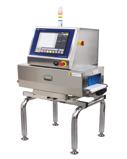
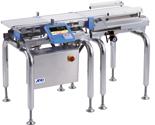
Visit: www.dpi.nsw.gov.au/agriculture/water/ clean-coastal-catchments
Visit: www.marine.nsw.gov.au/marine-estateprograms/marine-estate-management-strategy
Acknowledgements
The CCC Research Project is delivered by the NSW Department of Primary Industries and is funded through the NSW Marine Estate Management Strategy 2018-2028.
References
Kadlec, R. H. (2009). “Nitrate dynamics in event-driven wetlands.” Ecological Engineering In Press, Corrected Proof.
Robertson, W. D. (2010). “Nitrate removal rates in woodchip media of varying age.” Ecological Engineering 36(11): 1581-1587.
White, S.A., Morris, S.S., Wadnerkar, P.D., Woodrow, R.L., Tucker, J.P., Holloway C.J., Conrad, S.R., Sanders, C.J., Santos, I.R. (2021). Improving water quality downstream of blueberry farms: Trial of a novel surfaceflow bioreactor design. National Marine Science Centre, Southern Cross University, Coffs Harbour, NSW. 43 pages.
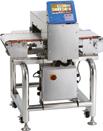
93 Talk to A&D today about how to reduce giveaway and improve product quality. Locally Stocked and Supported in Australia. Inspection Systems | Metal Detectors | Checkweighers | Data Capture PREVENT PRODUCT RECALL REDUCE PRODUCT GIVEAWAY or visit: www.andinspection.com.au 1800 241 434
The ABGA is funding a major marketing & export program – please contribute your share
Why should I pay the voluntary levy?
The voluntary levies fund all of the essential activities that contribute to the growth of our blueberry industry. Activities include, but are not limited to:


• Maintaining a a dedicated marketing campaign
• Research & development into registered chemicals + IPM + Integrated Disease Management programs
• Funding legal advice to support appropriate planning conditions
• Progressing applications for market access to key markets such as New Zealand, South Korea, Taiwan and Vietnam
• Developing export protocols into Japan
• Funding our Industry Development Officer
• Funding our Executive Director and support staff
• Communication and engagement with members –industry journal, e-news, website, conference
• Promoting positive industry stories and addressing negative media
• Providing our contribution to Hort Innovation under the Collective Industry Fund which is matched with equal funding used for various industry projects as determined by the Blueberry Strategic Industry Advisory Panel
How much levy do I have to pay?
For this year standard levies are $0.07/kg fruit sold. This will cover both R&D and Marketing investments.
When do I pay the voluntary levy?
Levies are payable once every financial quarter: Quarter Period Covered Payable by
Q1 1 July – 30 September 31 October
Q2 1 October – 31 December 31 January
Q3 1 January – 31 March 30 April
Q4 1 April – 30 June 31 July
How do I pay the levy?
Follow the steps below:
1. Prepare a statement with the following information
• Grower Name
• Quarter + Dates (e.g. Q2 1st Oct - 31st Dec)
• Number of kg fruit sold in that quarter
• Amount of levy being paid
• Indicate if your agent deducts your levies (if so, include agent name)
2. Email the statement to the Membership Officer
Email statement to: admin@berries.net.au
The Membership Officer will send you an Invoice for payment
3. Pay your levy to the ABGA account
Account name:
Bank:
BSB:
Account:
Reference:
Australian Blueberry Growers’ Association Westpac 033 107 181 471 GROWER NAME + Financial Quarter (e.g. “Joe Bloggs Q2 levy”)


My agent deducts levies — what do I need to do?
Send the Membership Officer a statement as per Step 1 above. She will then check that the agent has paid the levy. Email the statement to admin@berries.net.au
What about confidentiality of the information provided?
Any information provided will be kept confidential. I need help, who do I
Wendy Morris
contact?
Email: admin@berries.net.au | Phone: 0491 751 123
VOLUNTARY LEVIES
SUPPORT YOUR INDUSTRY TO SUPPORT YOUR BUSINESS!
AUS TRALIAN Blueberries
Marketing Update — ABGA & Wavemaker
Delaney Lang-Lemckert – Client & Performance Associate Manager, Wavemaker
Wavemaker Brisbane has continued to work with Australian Blueberries to shift Blueberries from being an impulse purchase, to a grocery basket staple. The campaign has driven strong results so far, driving an increase in the number of households buying fresh blueberries.

E-commerce
Organic Social
The management of the social media content and community engagement continues to drive strong reach across Facebook and Instagram.
The content continues to focus on recipes, blueberry facts and industry insights to ensure audiences remained engaged with a more consistent posting schedule. Industry insights and blueberry facts are the top-performing content with audiences frequently sharing positive sentiment regarding the content. All content continues to generate strong levels of sharing, saving and liking which has helped in increasing reach figures across the account.
User generated content continues to be re-posted across social platforms, and the higher-quality and engaging reels and static posts have generated great conversation and awareness amongst audiences who continuously comment positive commentary about Australian Blueberries.
The retail budget has been split between Woolworths and Coles to effectively target grocery buyers shopping online. Both campaigns have been live since August 2022, generating strong and efficient sales volume.
Woolworths
The Woolworths campaign has driven over $31.1k in revenue from 7,289 sales of Blueberries. Overall, the campaign has delivered strong levels of awareness with a total of 47,684 impressions and healthy volume of consideration at 7,656 clicks to the products.

Coles
Coles is the stronger performing retail campaign, from a revenue perspective, generating over $43.9k in revenue from 10,948 sales.
BLUEBERRIES
95
Creators
Creators continue to be engaged through the influencer marketing platform, Vamp. Creators have increased the awareness of blueberries whilst also inspiring usage occasions and ensuring Blueberries are a grocery basket staple. Creators have been strategically chosen to align with the campaign goals and 3pm slump strategy.
Further, the content created has helped illustrate how blueberries can be enjoyed as the perfect snack and incorporated into recipes and everyday meals. The influencer campaign was split into two bursts, with the second burst currently live.
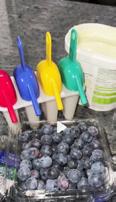


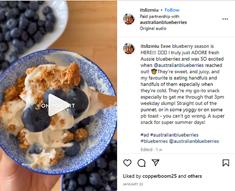
Instagram creators have reached 75,377 Australians through their highly engaging and educational content. Reels have driven the greatest share of the unique reach, responsible for 88% (66,430) of the total unique reach, indicating that video content should be the preferred style of content created by influencers.

TikTok creators have generated 9 pieces of content, and have driven 627,035 views so far, demonstrating that by aligning with these influencers, we’ve been able to efficiently and effectively reach our target audience and inspire usage occasions and drive purchases.

Top-performing Creators
The top-performing creators across this second burst are @itslizmiu from Instagram and @bynessa_ from TikTok.
Both creators showcased how blueberries are the perfect, healthy snacking option, especially when experiencing that “3pm slump.”

If you have any questions about the current season or if you’d like to be a part of the grower content, please contact: berriesaustralia@wmglobal.com | www.australianblueberries.com.au
instagram australianblueberries
96 BERRY AUSTRALIAN JOURNAL AUTUMN 2023 EDITION 14
@itslizmiu was able to generate 67% of Instagram’s total unique reach and her reel generated 155 saves, indicating that audiences were engaged by her content.
@bynessa_ post generated an impressive 4,332 likes, accounting for 37% of overall likes delivered through Tik Tok, demonstrating that audiences enjoyed her content.
| FACEBOOK-SQUARE
Profile: Rainberry Farm, Tasmania
 Mark Salter, Berry Industry Development Officer, Fruit Growers Tasmania
Mark Salter, Berry Industry Development Officer, Fruit Growers Tasmania
Located in Forcett in southern Tasmania, Rainberry is a collaboration between Ken Rainsford, Lauren Meredith and Andrew Bell
The Rainberry team
Ken leads the production operations within the business, having moved back to Tasmania a few years ago to rekindle his love of farming after seeing the potential for berry production in south-eastern Tasmania. Before this, Ken built telecommunications infrastructure and managed teams for the NBN network, and played football in several states –not your usual farming background!
Lauren leads much of the coordination and end-toend administration of the business, including people, planning and logistics. With lots of previous experience in procurement and logistics for retail, packaging and safety businesses, Lauren has enjoyed stepping out of the corporate environment and into commercial berry production.
Complementing Ken and Lauren is Andrew Bell from Mountain Blue, who brings valuable knowledge about the genetics, agronomy and marketing of Rubus berries. Andrew and the Mountain Blue team provide a rounded suite of experience and support, which has helped Rainberry to grow and flourish.
Production
The farm grows varieties with genetics sourced from overseas via Mountain Blue. All the plants are grown in coir in pots under poly tunnels. The water comes from the south-eastern Tasmanian irrigation scheme, pumped directly into large storage tanks on the farm before being distributed to the plants via a Priva irrigation and nutrition management system.
Ken explains that Tasmania’s favourable climatic conditions and freedom from pests like fruit fly provide great growing conditions for big high-quality berries, and that the main variety in production at Rainberry is the Enrosadira (PBR 2017050) raspberry variety.
The raspberries harvested this year travelled as far as supermarkets in Adelaide and Sydney with positive retailer feedback and customer demand. As newer entrants in the berry industry, Lauren notes that it is a sophisticated industry with lots to learn, and that having production and marketing partners in Mountain Blue has been essential to support the development of agronomy, outbound sales processes and industry knowledge.
RUBUS
from Mountain Blue.
97
Poly tunnel system in use at Rainberry Farm. Photo credit: Mark Salter

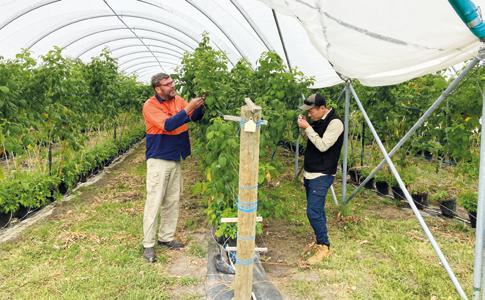
98 BERRY AUSTRALIAN JOURNAL AUTUMN 2023 EDITION 14
Poly tunnel system in use at Rainberry Farm. Photo credit: Mark Salter
Ken Rainsford (Farm Manager) and Tetsuya (agronomist) inspecting raspberry plants. Photo credit: Mark Salter
Pushing back against inflation






Lauren sees some of the major challenges for growers being how to manage production input costs with growing inflation and the challenging labour market. Not only have materials like packaging, fuel, fertiliser, agrichemicals and labour all increased in cost dramatically, but growers in Tasmania are also facing rising prices for Bass Strait shipping and road freight, which further squeezes profitability each time they bring in materials or send fruit to the mainland.
For Rainberry, labour is sourced from a combination of local and seasonal workers. Ken sees lots of nationalities onsite throughout season, making for a really diverse team. The workforce also includes semi-professional local pickers and students most of whom live full-time in Tasmania. Rainberry also recently welcomed their first cohorts of seasonal workers from Vanuatu through the PALM Scheme, complementing the locally available workforce and helping to take the edge off a very strong summer peak this year.
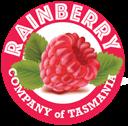
In this challenging environment, Lauren sees opportunities for businesses and industry sectors to work together to grow and support each other, whether through using group buying to reduce input and freight costs, sharing of seasonal labour pools, or working together to help cope with unexpected equipment breakdowns. In working together in this way, growers can strengthen our Tasmanian brand and reduce the cost of trade together.
Looking to the future
With the challenging conditions facing the industry, Lauren and Ken say they are currently focusing on further optimising their production systems before considering further expansion.




Australia - wide Sales, Service & Spare Parts Ph 1300 763 141 aisgreenworks.com.au Greenhouse Solutions Irrigation Fertigation Substrates Plastic & Steel Gutter Water Treatment Climate Control Trellising Accessories
Profile: Jamie Pollen, Queensland Berries, Qld
Jen Rowling, Project Manager, Berries Australia
Queensland Berries was established in 2003 by Richard and Melissa McGruddy. Starting out as a small family-owned strawberry farm, the business has rapidly expanded to become one of Australia’s largest berry producers.

Strawberry production has continually increased since the early days and in 2008 they introduced raspberries, becoming the first commercial producers of Rubus varieties in Queensland. Blackberries followed and the small family-owned business is a now a vast enterprise operating across five sites in both the Moreton Bay and Granite Belt regions in South East Queensland.
With the significant labour required to not just maintain but continue to grow production for a business of this size and scope, Richard and Melissa have invested heavily in access to a consistent and reliable workforce. In 2020, they become Approved Employers for the Pacific Labour Scheme (PLS) and then in 2021, they were approved for the Seasonal Worker Program (SWP).
RUBUS 100 BERRY AUSTRALIAN JOURNAL AUTUMN 2023 EDITION 14
Part of the team at Queensland Berries. Photo credit: Queensland Berries
They currently bring in workers from the Solomon Islands, Tonga and Timor-Leste and are exceptionally proud of their multicultural team.
Queensland Berries has also built a strong team of young and dynamic agronomists and production managers to work on the expansion of their extensive protected cropping systems, with responsibility for the management of plant health, fruit quality and all aspects of production across their strawberry and Rubus crops. These bright young people are the future of the Australian berry industry and to support their continued development, Berries Australia introduced the Emerging Leaders program at last year’s BerryQuest International 2022.
One such future leader is 25-year-old agronomist
Jamie Pollen who joined Queensland Berries in January 2022 with a Bachelor’s degree in Sustainable Agricultural Science, majoring in Agronomy and an enthusiasm for what she does which has seen her progress quickly in her role with the business. Jamie was the recipient of an Emerging Leaders Bursary to attend BerryQuest International 2022 and is a shining example of the passionate and talented young people building their careers in the berry industry.
We caught up with Jamie recently to talk about her role with Queensland Berries and to get her thoughts on the opportunities and challenges for other young people working in the Australian berry industry.

In agronomy there will always be problems that need solving and many exciting possibilities to be uncovered. They say working in agriculture means every day will be a new and exciting adventure and I agree. Rarely are any two days the same.
One of the main reasons I chose this career is that work done in agriculture today passes on something to those who come tomorrow. Whether you are working on the latest technology and research or continuing a long family tradition, agricultural jobs leave a legacy like no other, and I’m passionate about both agronomy and the desire to create change.
What is your current position at Queensland Berries and what crops do you work with?
Since starting at Queensland Berries just over a year ago, my role has expanded considerably. I am now engaged with five of their sites across the Southern Queensland Region growing strawberry, blackberry, and raspberry crops after being promoted to the position of Production Manager.
The skills I developed during my time at the University of Queensland have enabled me to prove my ability to assess and manage complex obstacles. I am a strong trouble-shooter and successful in intense and demanding environments, providing decisive team leadership, and recognised for critical thinking.
I currently manage the growth and profitability of the business through forward planning and liaison with Driscoll’s to ensure timely delivery and application of planting and manipulations, alongside forecasting.
I also supervise all agronomy aspects for the improvement of overall crop health and yields, communicating better growing techniques, and adapting new techniques to improve the efficiency of maintenance and harvest tasks.
Jamie Pollen. Photo credit: Queensland Country Life
You grew up in North Queensland on a hobby farm so the great outdoors was in your blood, but was there anything in particular that made you follow this career path?
101
What have been some of your achievements so far?
I have been able to work with Richard and Melissa to implement systems to ensure Queensland Berries are at the leading-edge of horticultural technology, systems, and processes.
I’m proud to have applied efficient administration and planning practices to execute site-mapping and production planning for the next five years across each site. I have also planned the incorporation of a new irrigation system set-up and a six hectare expansion of one site. I was heavily involved in preparing the farm for the Berry Quest Farm Tour, whilst also providing agronomic support for a new variety of raspberry in addition to the current varieties grown.
One big project I completed was preparing and presenting a yield forecasting document per crop type, variety and site, that enables site mangers to see the predicted labour allocation for the coming season. This document enables the in-house registered labour hire team to arrange the workforce in advance, which is a critical part of the business operations.
There are several small trials we have completed to further optimise practices at Queensland Berries. For example, at one site this season a Blackberry crop underwent various pruning trials. This included different cane selections, canopy size and crop structure over six blocks. The results concluded that the correct timing and method of the prune that optimised the plants photosynthetic capabilities not only increased the yield drastically but also gave a more desirable quality and flavour.
What do you love about what you do?
My passion is problem-solving, and I’m not afraid of looking at old methods in a different way and making suggestions to improve and optimise practices. I am very fortunate to be in a position where I can voice my opinion and be heard.
I am a very level-headed and analytical person, and fortunately I have always had strong relationships with my peers, work colleagues and supervisors. Being a young female on a male dominated farm forced me to learn to speak up if I had any new ideas, opinions or problems. I strive to build and maintain good communication skills, be consistent, trustworthy and take ownership for my work.
It has also been helpful to have a good understanding of my strengths and weaknesses, and know when to ask for help myself or to offer assistance to others.
I love that every day is different and creates new challenges and opportunities to work with.
What are the challenges?
I have always had an interest in agricultural science and as the world’s population continues to expand, demand is high for agricultural scientists who can find sustainable solutions to the complex challenges of food security and nutritional value under a changing climate. I believe the challenges for the agricultural industry, as a whole, include meeting the consumer demands for food to be produced at higher quality standards. Additionally, it is concerning the lack of young agronomists graduating to keep up with the current developing technology and current national berry footprint.
An enterprise like Queensland Berries requires additional qualified young agronomists to support its expansion. The science behind growing berries in this region is establishing quickly yet there isn’t a proportional influx of agronomists graduating to implement these improved growing practices. I hope that articles like this inspire young people to consider this as a career and highlight the fact that we need more agronomists to support the industry.
What do you like most about working for Queensland Berries?
Over the past year I have learnt a multitude of skills from working at Queensland Berries. When I started as an Agronomist I could not have expected to progress into my current position as Production Manager so quickly. In saying this, I believe that I wouldn’t have been offered the freedom to grow this quickly in any other private sector.
I am very grateful to be given this opportunity to improve myself and apply skills other than agronomy to this business. In this year alone, I was involved from the very start of tunnel construction to planting to harvesting and on into the future expansion and varietal plans. It’s very satisfying seeing this development.
102 BERRY AUSTRALIAN JOURNAL AUTUMN 2023 EDITION 14
I was very grateful to meet other young growers and create networks with like-minded individuals from farms across the region. I loved the workshop run by Cynthia Mahoney that covered topics surrounding leadership, such as the Myers-Briggs Type Indicator® that helps you to understand your own personality better. It is crucial to firstly understand what personality type you are, so you are aware of your strengths, weaknesses, and possible conflicts with other personality types within your team. This skill is easily applied to the working environment to improve communication between team members and foster success. Using the information learnt from the course it enabled me to understand how I perform as a leader and how to increase productivity within my team.
What would help young emerging leaders like yourself to further develop your career in berries?
The berry industry in Australia has huge potential for growth, although I believe the focus needs to be directed towards optimising practices to create predictable yield and labour figures. Once this is achieved, the focus could shift to consumer demand and ensuring a consistent quality and flavour of the fruit produced.
With the limited number of agronomists graduating, there is even more of a demand for industry support for current graduates. As a young emerging leader that intends to further develop my career in the berry industry, I would suggest continuing in the process of developing a ‘Young Berry Farmers’ group for the region. It will be built into ongoing learning opportunities for the young agronomists and a chance for us to create networks of like-minded individuals from farms across the region to share best practice and learn from each other.
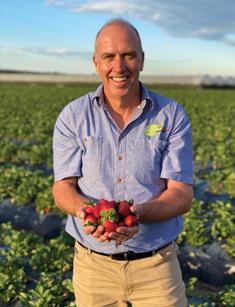
And finally, what’s your favourite berry – to grow and to eat?
My current favourite berry to grow would have to be the Elvira blackberry variety. It’s an absolute monster of a crop and can be very easily overcropped. I find it particularly interesting the difference in the cropping habit of the floricane crop when compared to the primocane. I have only experienced one season with Elvira, but during the floricane crop, when manipulated correctly, the plant produces aggressive quantities of berries in a very short window. The agronomy driving this yield is canopy management and comes dozwn to the science of maximising the photosynthetic capabilities through increasing sunlight interception through cane selection of the plant.
Although the Elvira Blackberry is fascinating to grow, I am very partial to blueberries as my favourite fresh berry to eat! Hopefully, it will be another berry crop I can add to my portfolio very soon!
As an Emerging Leaders Bursary recipient, what did you enjoy about the Emerging Leaders program at BerryQuest 2022 and was there anything that you learnt about leadership that you have been able to apply to your work?
103
Richard McGruddy, Queensland Berries. Photo credit: Queensland Country Life
SMART SOLUTIONS FOR PROTECTED CROPPING
Tapex Horticulture Group provides innovative product solutions to the Australasian horticulture industry through its trading companies, Polygro (Australia) and GreenLife Structures (GLS).


With trusted global brand partners for over 20 years in horticulture sector, Tapex Horticulture Group is an Australian-owned-and-operated company that designs, manufactures and installs exceptional quality commercial greenhouses, cablespan shade structures and protective netting, as well as other non-chemical protective cropping solutions to the protected cropping industry.
• Premium Greenhouse and Shade Structures.



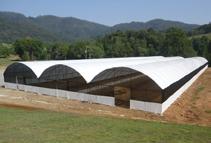

• Australian made, Engineered and Design Certified.
• Sales, Design, Fabricate, Install and Service.
e: sales@greenlifestructures.com.au

w: greenlifestructures.com.au
p: +61 2 6686 7321
• National Supplier of Horticultural Products.
• Tunnels, Crop Protection, Netting and Film, Landscaping products, Growbags and Accessories.

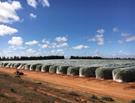
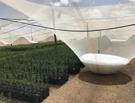

e: sales@polygro.com.au
w: polygro.com.au
p: +61 2 9502 6000
H o r t icu l t u r e
Group
Tapex Horticulture Group 200 Kingsgrove Road, Kingsgrove NSW 2208, Australia +61 2 9502 6000 | rvallett@tapexhortgroup.com.au | www.tapexgroup.com.au
DID YOU KNOW?
of consumers would pay more for ethically sourced food.* 25%
Fair Farms is the only Australian Training and Certification Program for fair and ethical employment practices on farm.
Developed for industry by industry and supported by the Federal Department of Agriculture, Water and the Environment.
Register with the national Fair Farms program today and join a growing community of Australian farmers demonstrating workplace relations and WHS compliance.

Signup today and receive access to relevant tools and resources that lead to a pathway to certification, supported and accepted by the industry.
To join visit: www.fairfarms.com.au
YOUR BERRIES AUSTRALIA TEAM
EXECUTIVE DIRECTOR
Rachel Mackenzie 0408 796 199 rachelmackenzie@berries.net.au
PROJECT MANAGEMENT
Jen Rowling 0448 322 389 jenrowling@berries.net.au
*Please contact Jen for any Qld or NSW related issues whilst we replace staff in those states
PROJECTS
Export —
Jenny Van de Meeberg
0410 536 269 export@berries.net.au
Communications —
Jane Richter 0431 700 258 berrycomms@berries.net.au
Recovery & Resilience —
John Hay 0488 147 800 recovery@berries.net.au
MEMBERSHIP, ADVERTISING & ADMINISTRATION
Wendy Morris 0491 751 123 admin@berries.net.au
VICTORIA & SOUTH AUSTRALIA
Angela Atkinson 0408 416 538 ido@vicstrawberry.com.au
TASMANIA
Mark Salter 0400 100 593 berryido@fruitgrowerstas.org.au
WESTERN AUSTRALIA
Helen Newman 0428 335 724 helen.newman@dpird.wa.gov.au
Aileen Reid 0467 783 981 aileenfr@bigpond.net.au
www.berries.net.au









































 0400 100 593 | berryido@fruitgrowerstas.org.au
0400 100 593 | berryido@fruitgrowerstas.org.au










 Visit Melbourne Markets which moved to its current location in Epping at the end of August 2015.
Visit Melbourne Markets which moved to its current location in Epping at the end of August 2015.















 Mark Salter, Berry Industry Development Officer, Fruit Growers Tasmania & Dave Farmer, Croplands
Mark Salter, Berry Industry Development Officer, Fruit Growers Tasmania & Dave Farmer, Croplands

















































 John Hay, Industry Recovery & Resilience Officer, Berries Australia
John Hay, Industry Recovery & Resilience Officer, Berries Australia



 Helen Newman, Berry Industry Development Officer, Agricultural Produce Commission (WA)
Helen Newman, Berry Industry Development Officer, Agricultural Produce Commission (WA)






































 The East Seaton farm in Scotland – owned by John’s cousin who is also Chairman of Angus Soft Fruits- where strawberries are grown on table tops as part of a 150 hectare tunnel system. This is just one of multiple farms growing berries both in the UK and overseas in collaboration with Angus Soft Fruits enabling the business to offer year-round supply to its customers.
Photo credit: Liam Anderstrem, Airborne Lens Company
Strawberries growing on table tops at Angus Soft Fruits.
Photo credit: Angus Soft Fruits
John Gray. Photo credit: Angus Soft Fruits
The East Seaton farm in Scotland – owned by John’s cousin who is also Chairman of Angus Soft Fruits- where strawberries are grown on table tops as part of a 150 hectare tunnel system. This is just one of multiple farms growing berries both in the UK and overseas in collaboration with Angus Soft Fruits enabling the business to offer year-round supply to its customers.
Photo credit: Liam Anderstrem, Airborne Lens Company
Strawberries growing on table tops at Angus Soft Fruits.
Photo credit: Angus Soft Fruits
John Gray. Photo credit: Angus Soft Fruits





 Installing pipes to drain waste water from 300 potted blueberries, into a sump tank that will feed the bioreactor and wetland structures, at the Wollongbar Primary Industries Institute.
Photo credit: Diana Unsworth
Figure 1. Design schematic. Source: Mark Bayley Consulting
BR1 BR2 BR3
Installing pipes to drain waste water from 300 potted blueberries, into a sump tank that will feed the bioreactor and wetland structures, at the Wollongbar Primary Industries Institute.
Photo credit: Diana Unsworth
Figure 1. Design schematic. Source: Mark Bayley Consulting
BR1 BR2 BR3



















 Mark Salter, Berry Industry Development Officer, Fruit Growers Tasmania
Mark Salter, Berry Industry Development Officer, Fruit Growers Tasmania


























